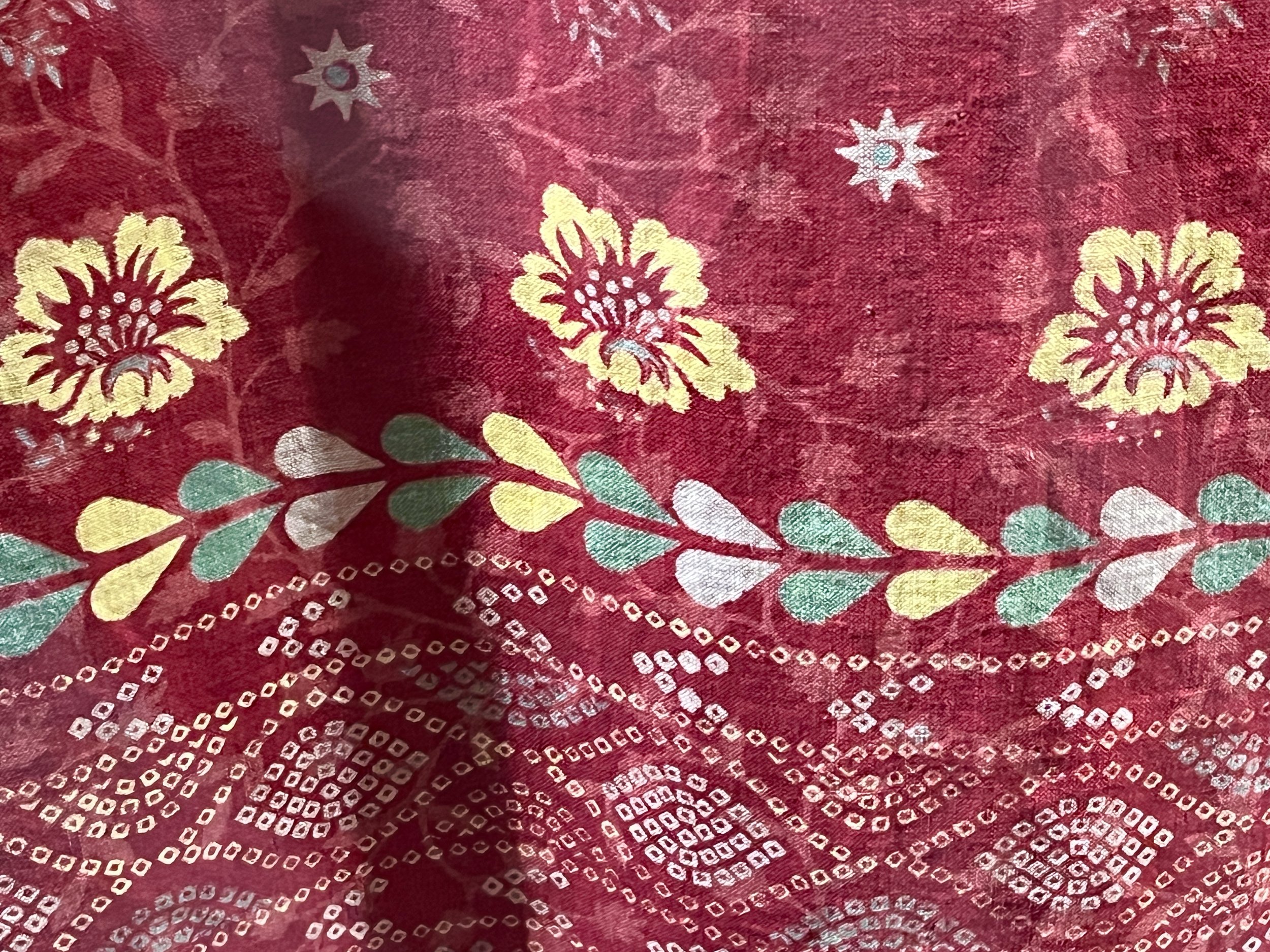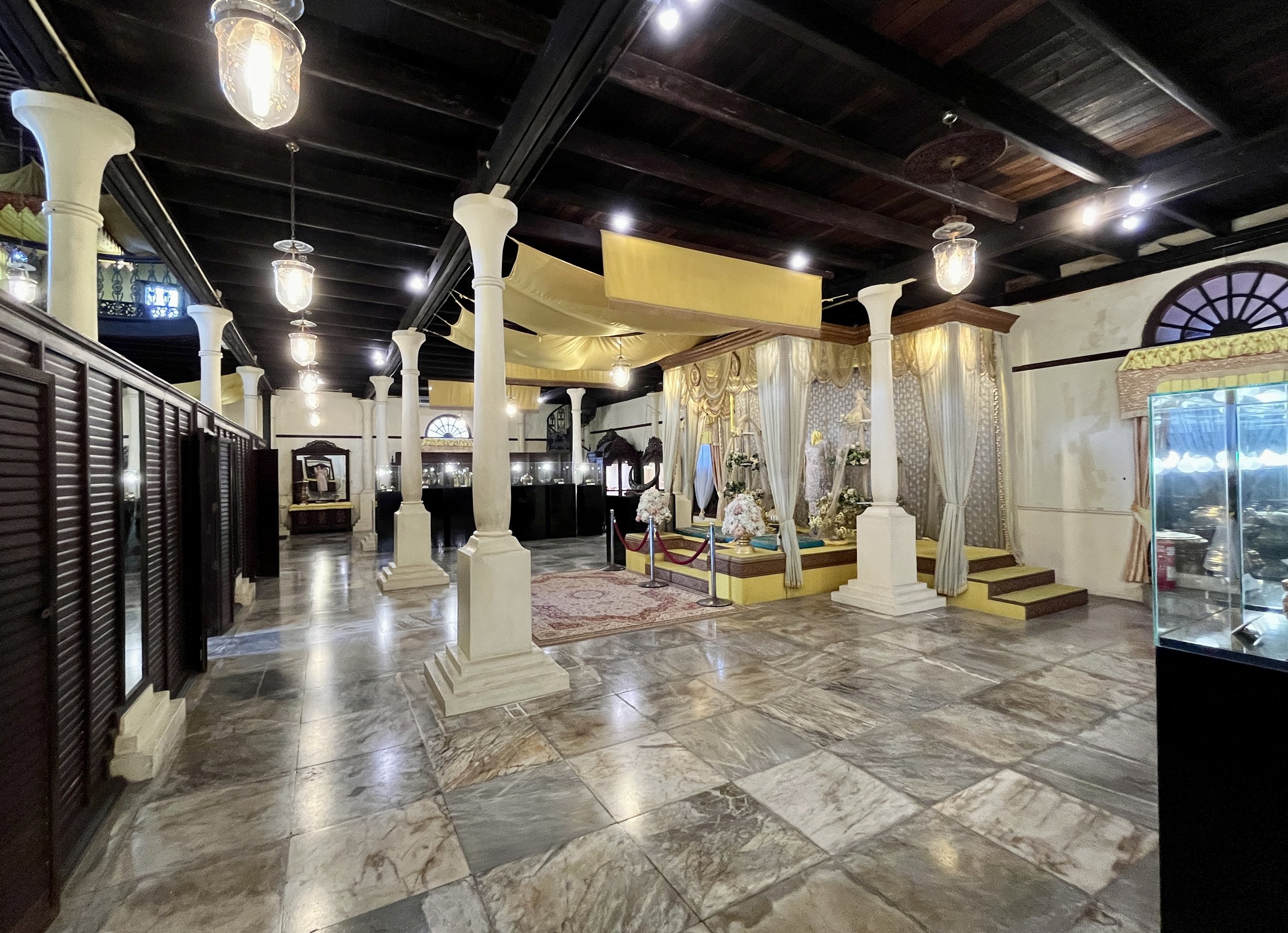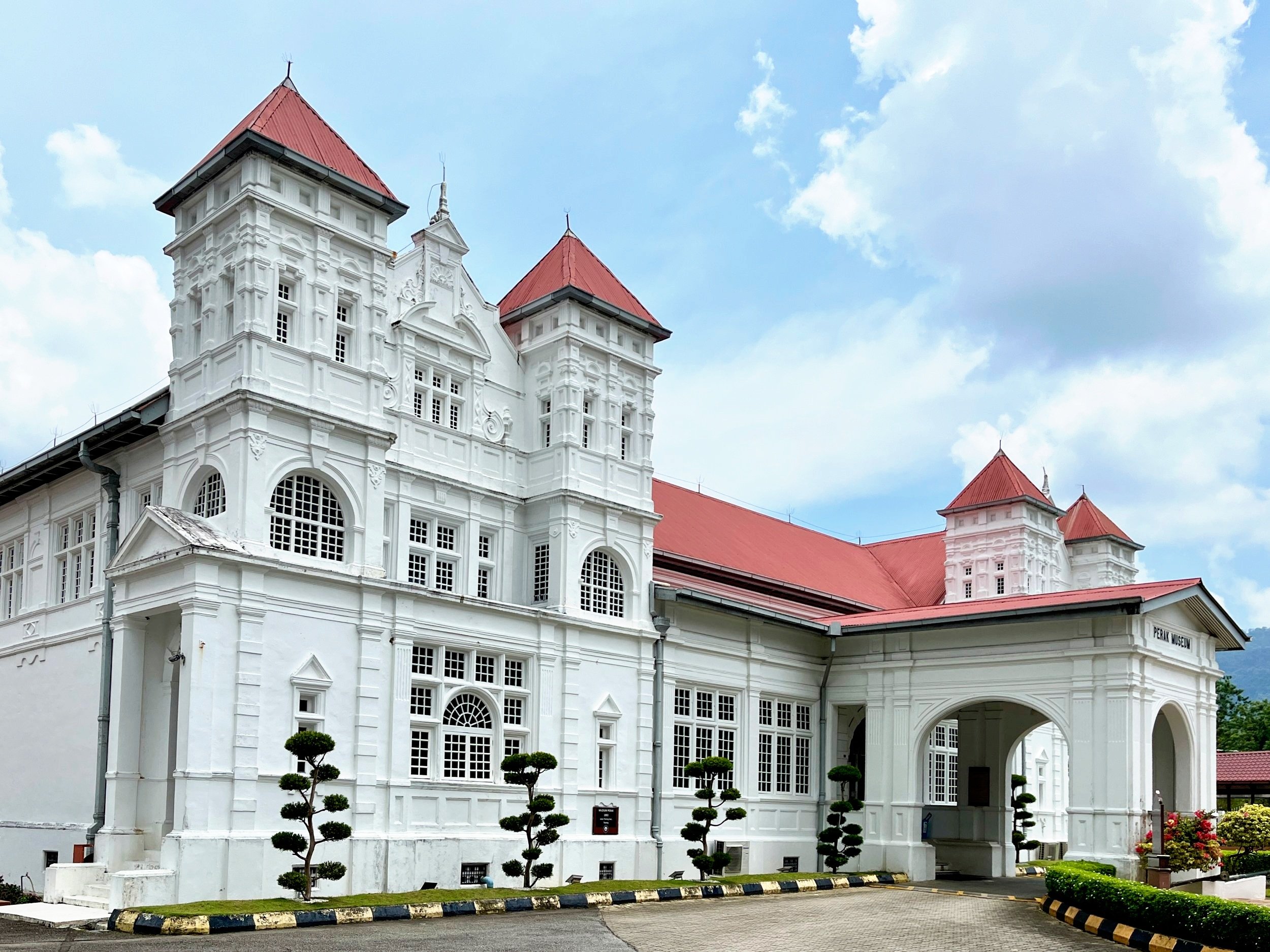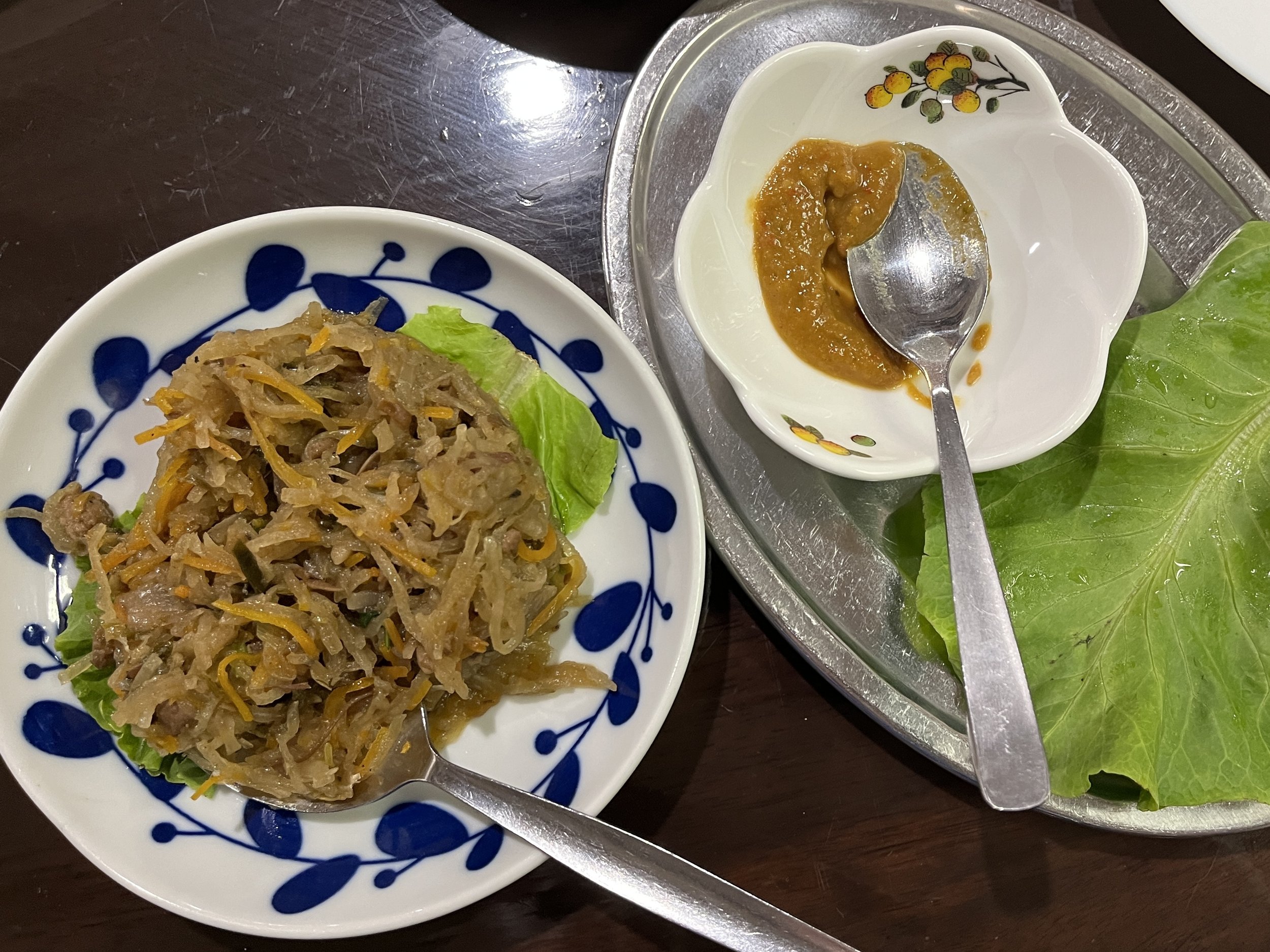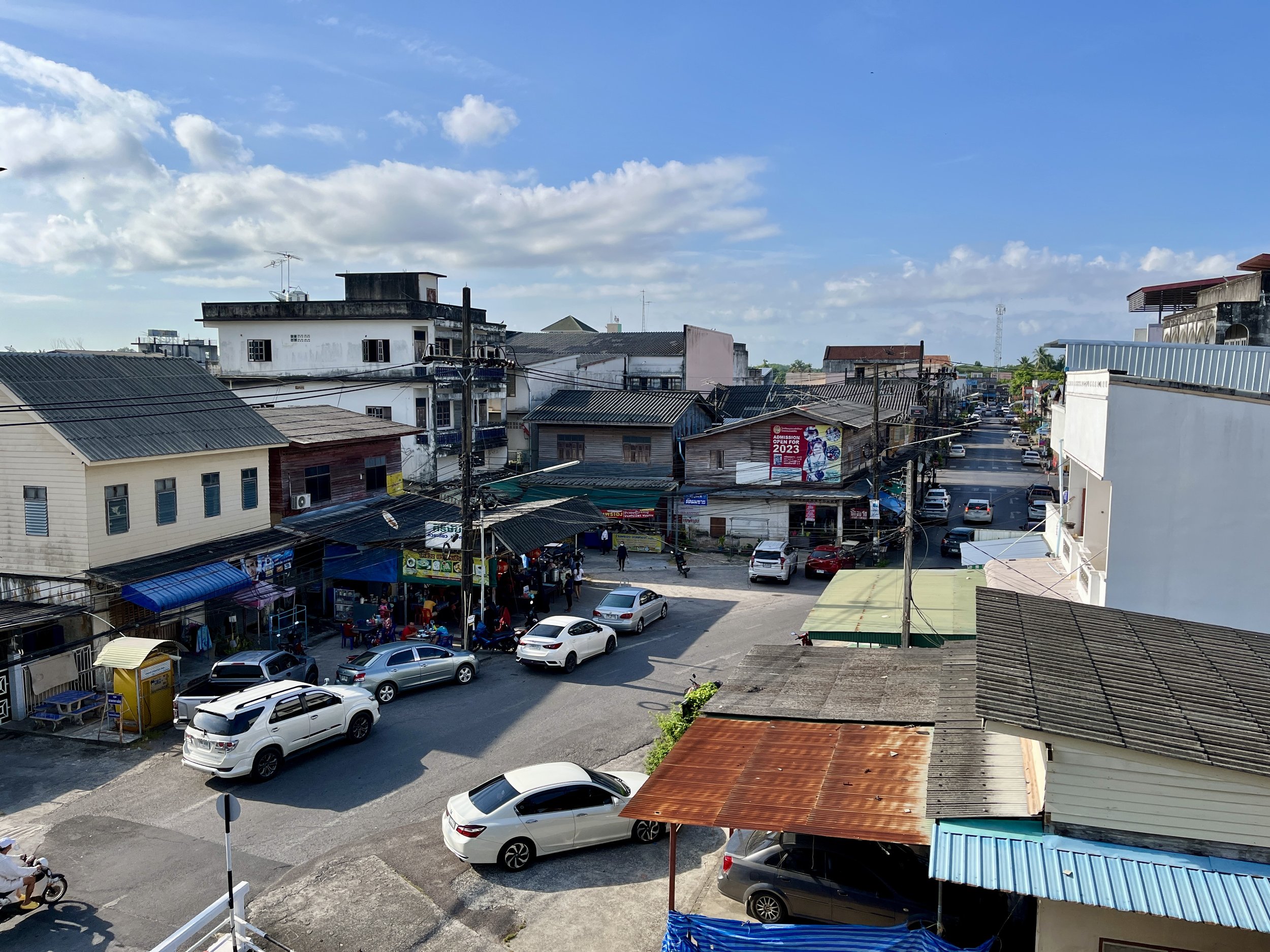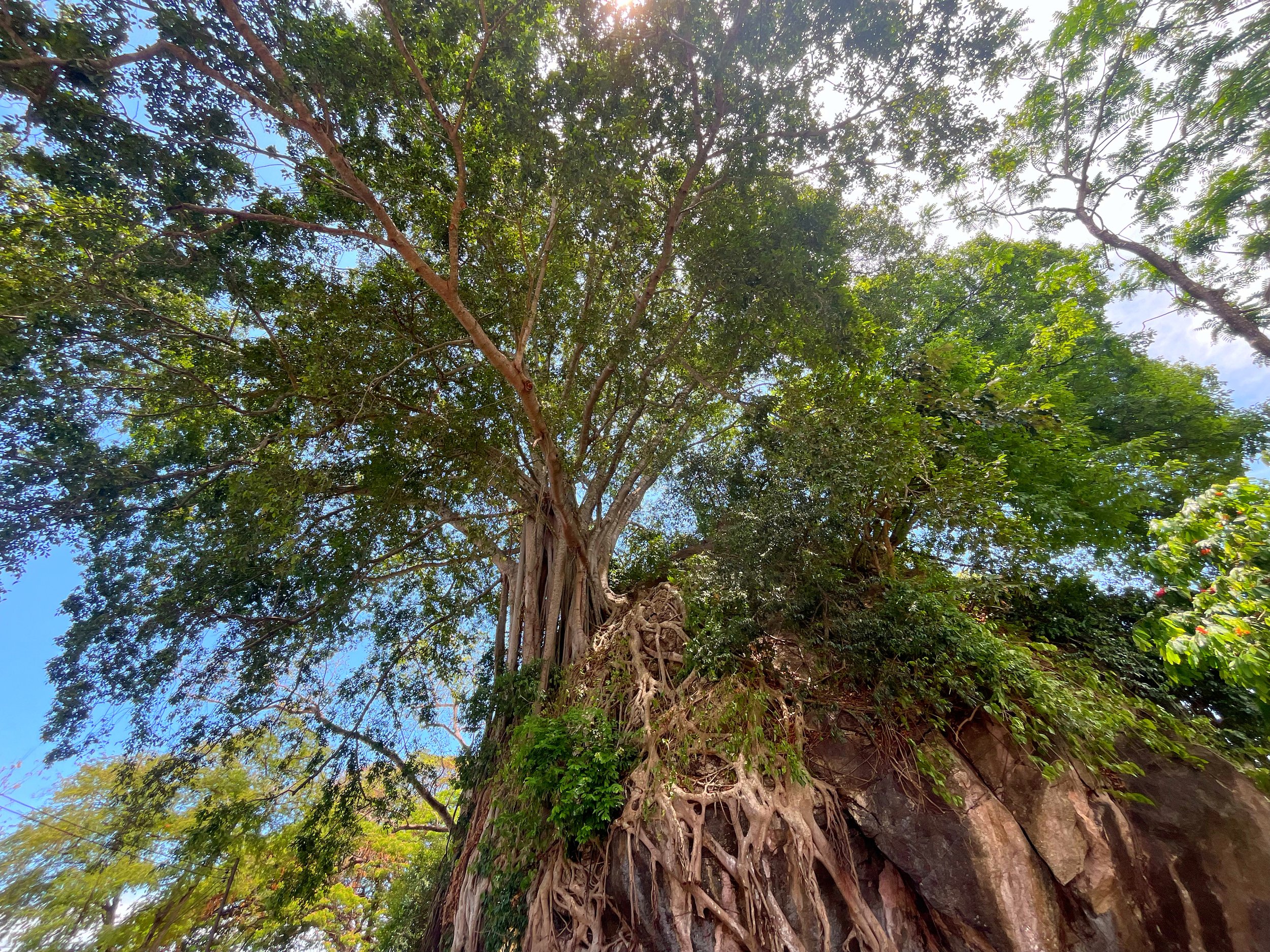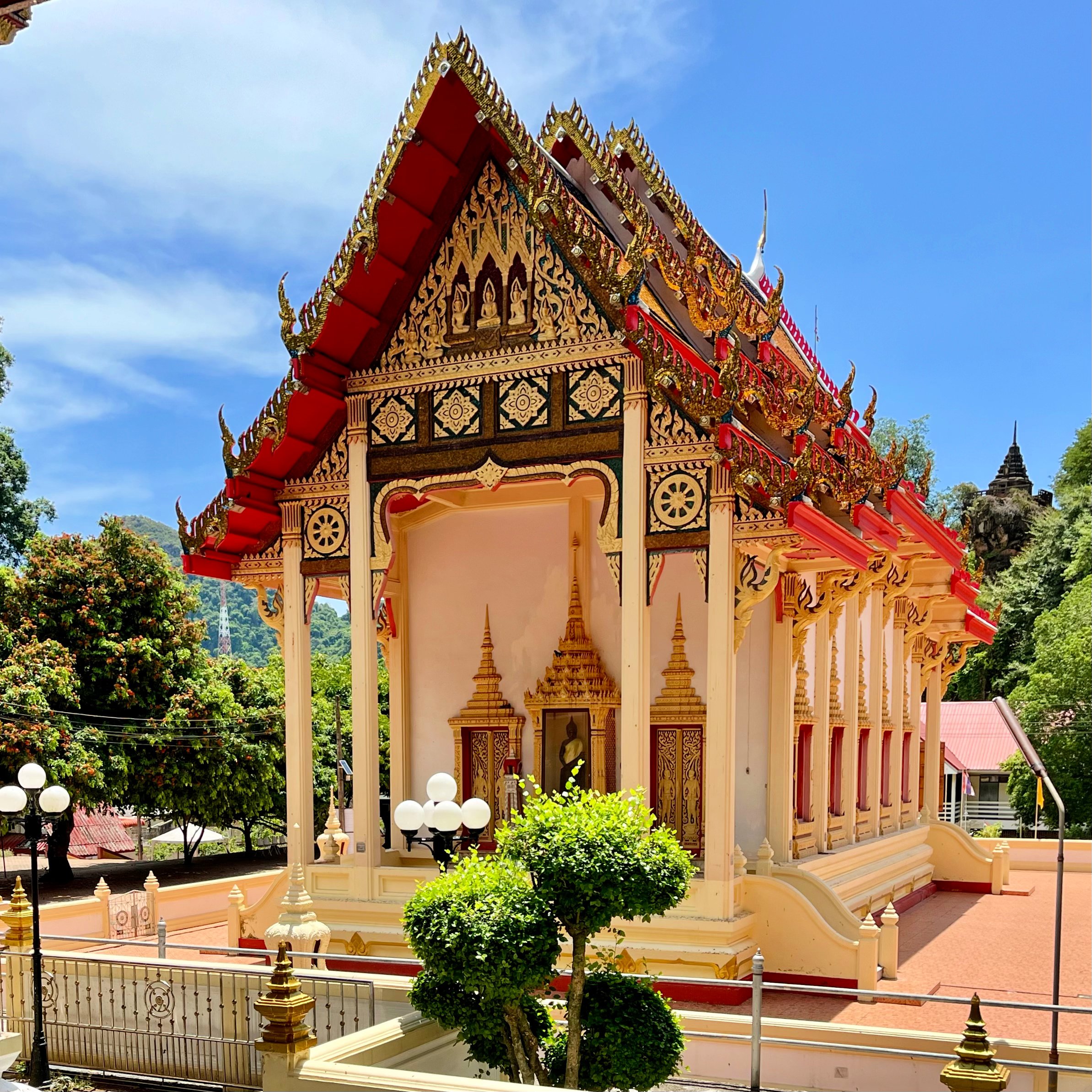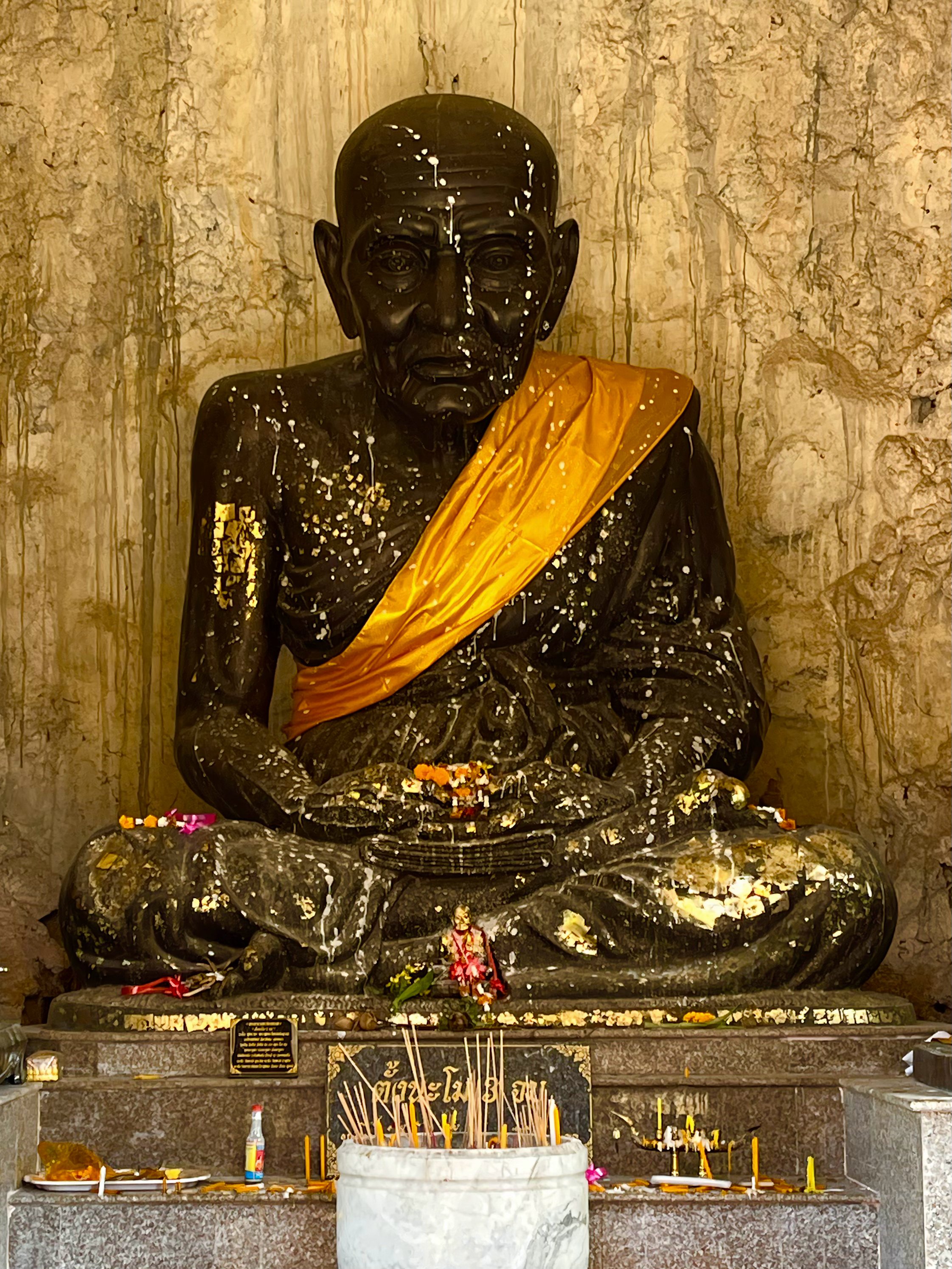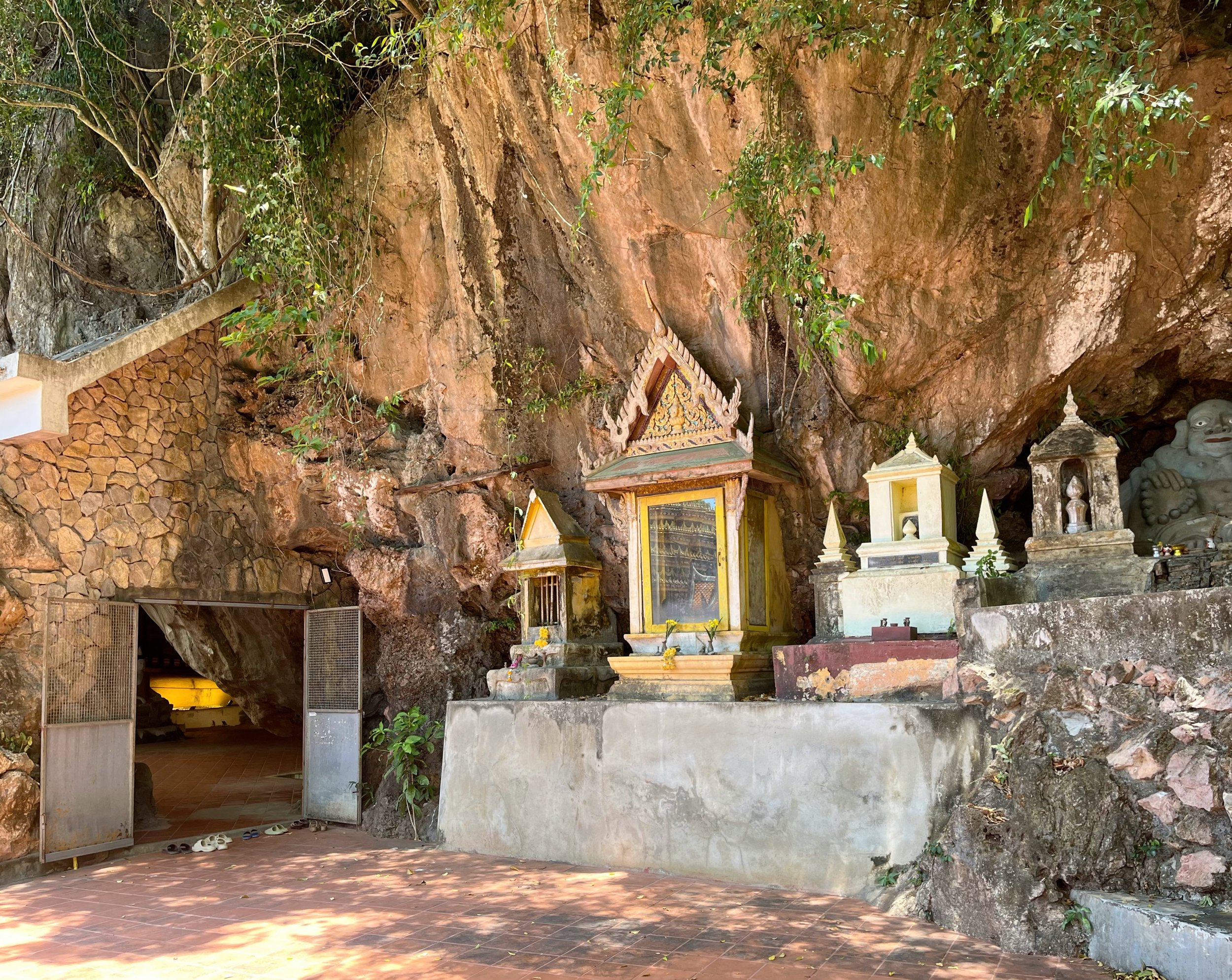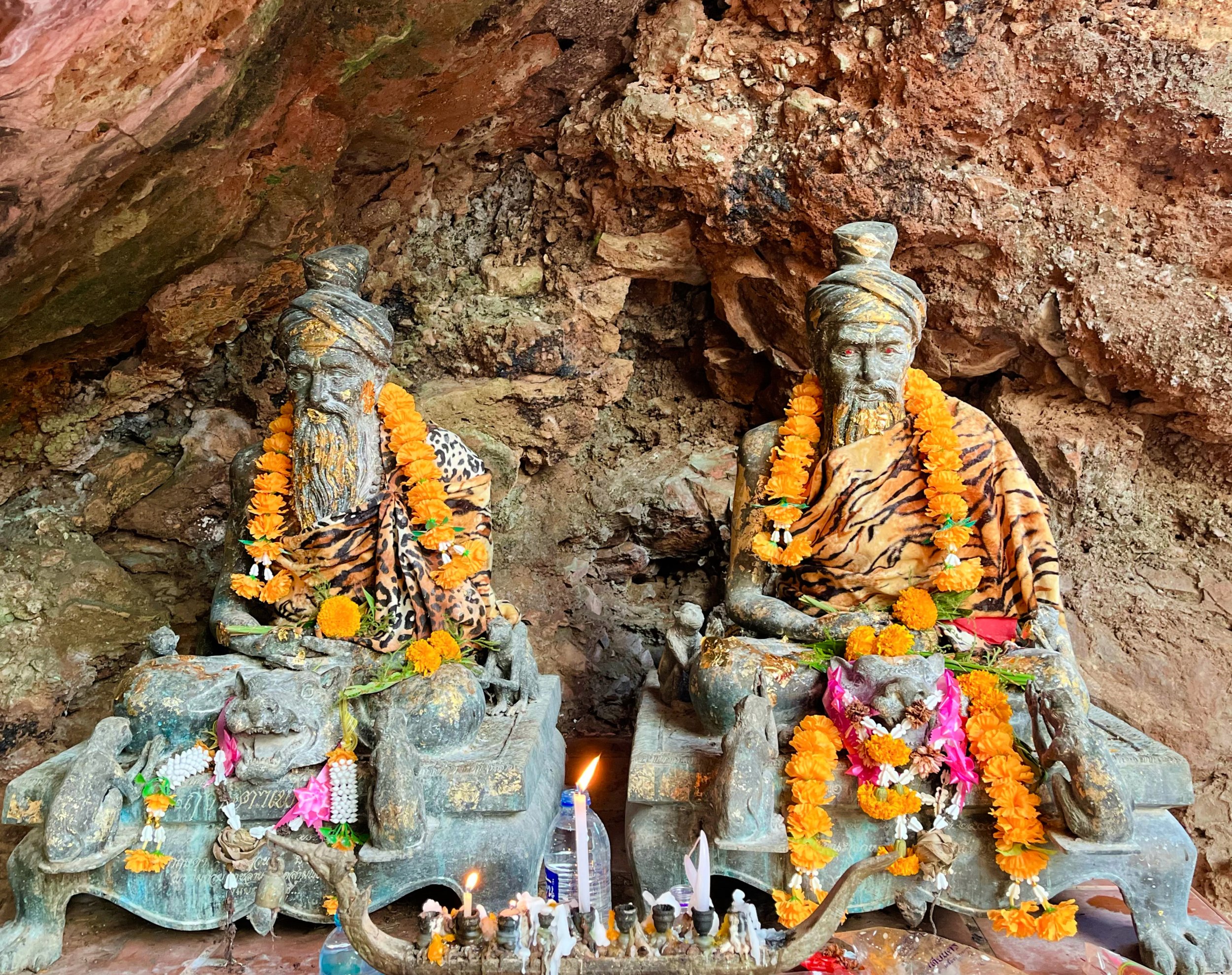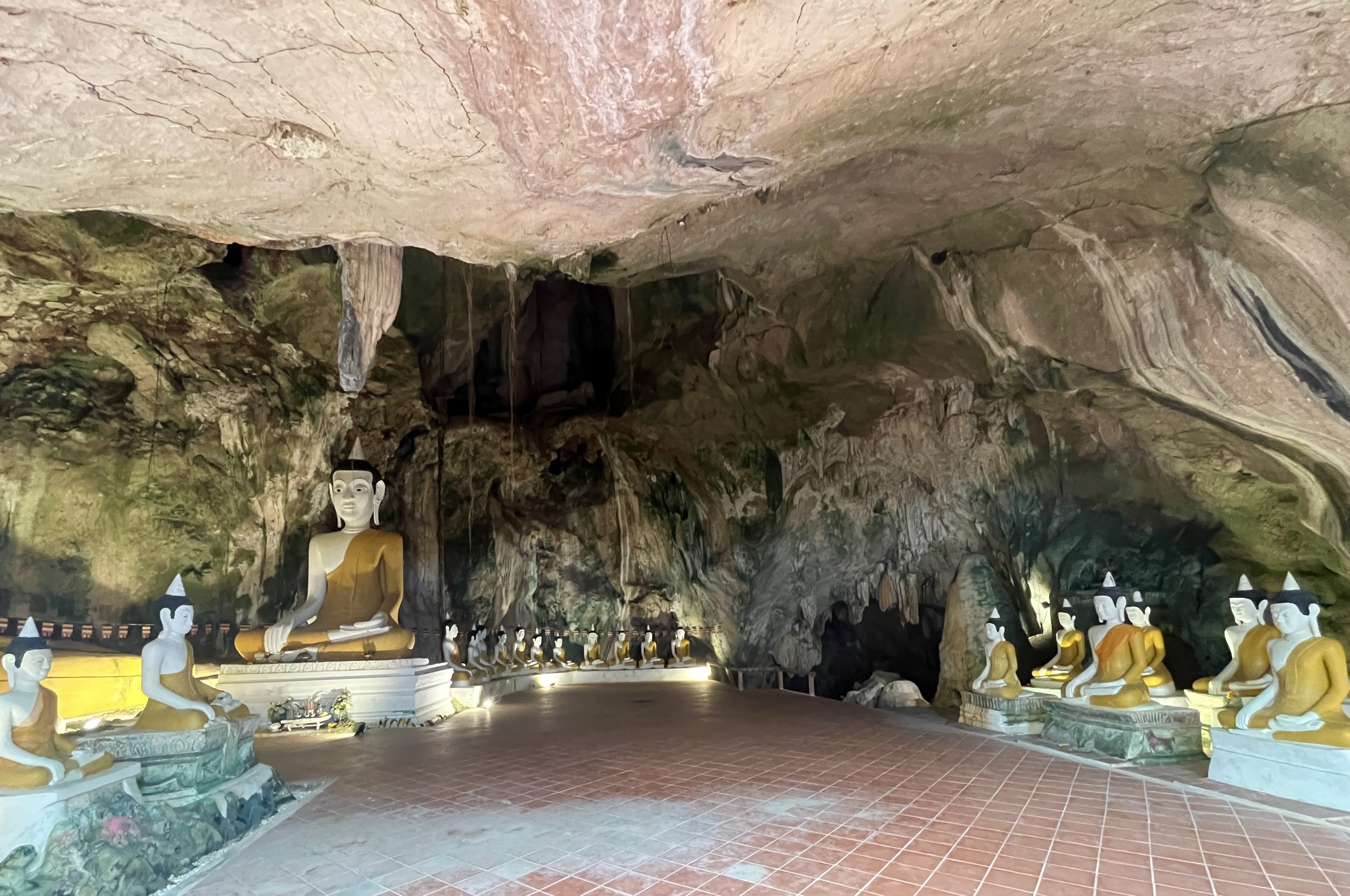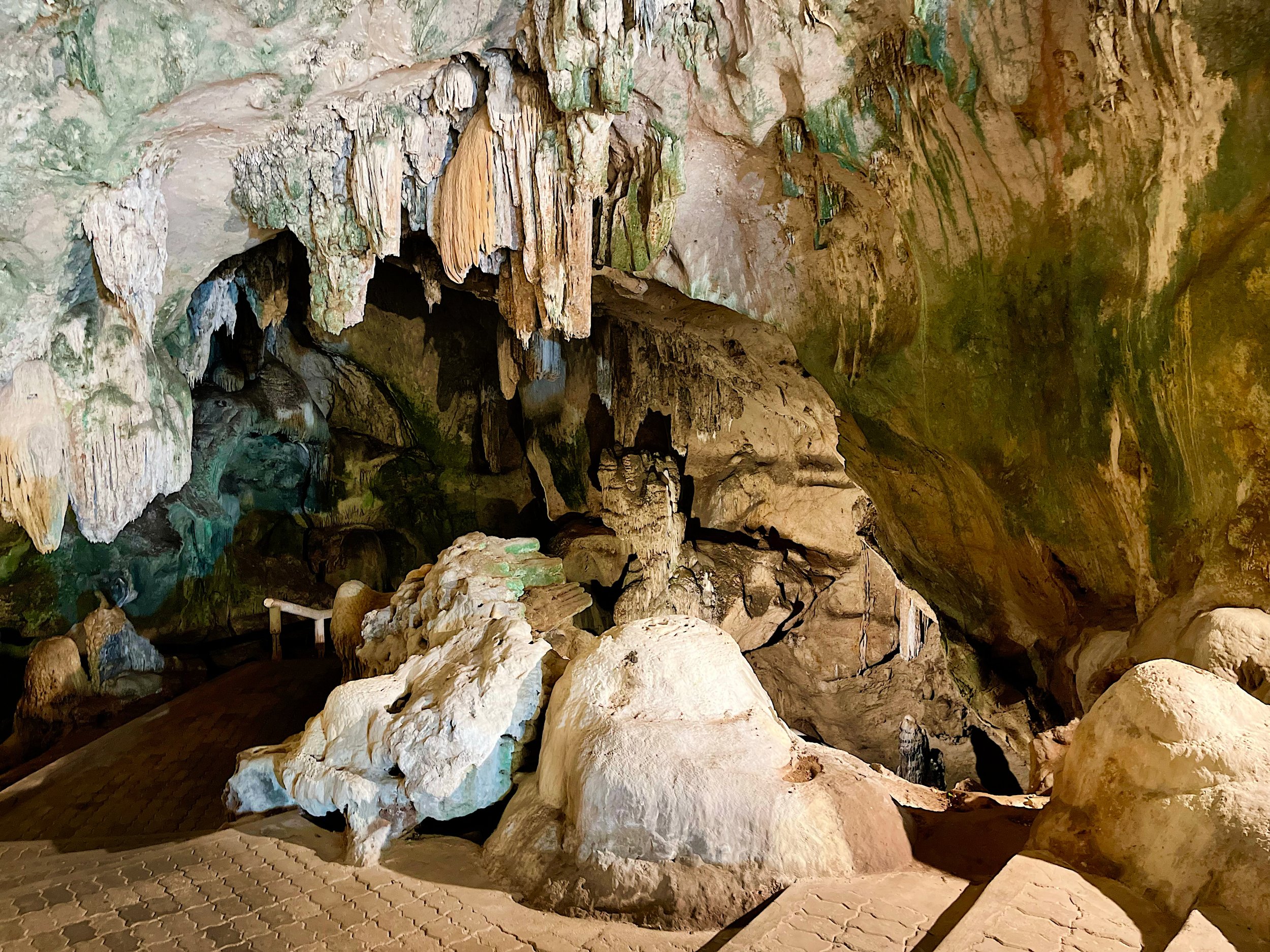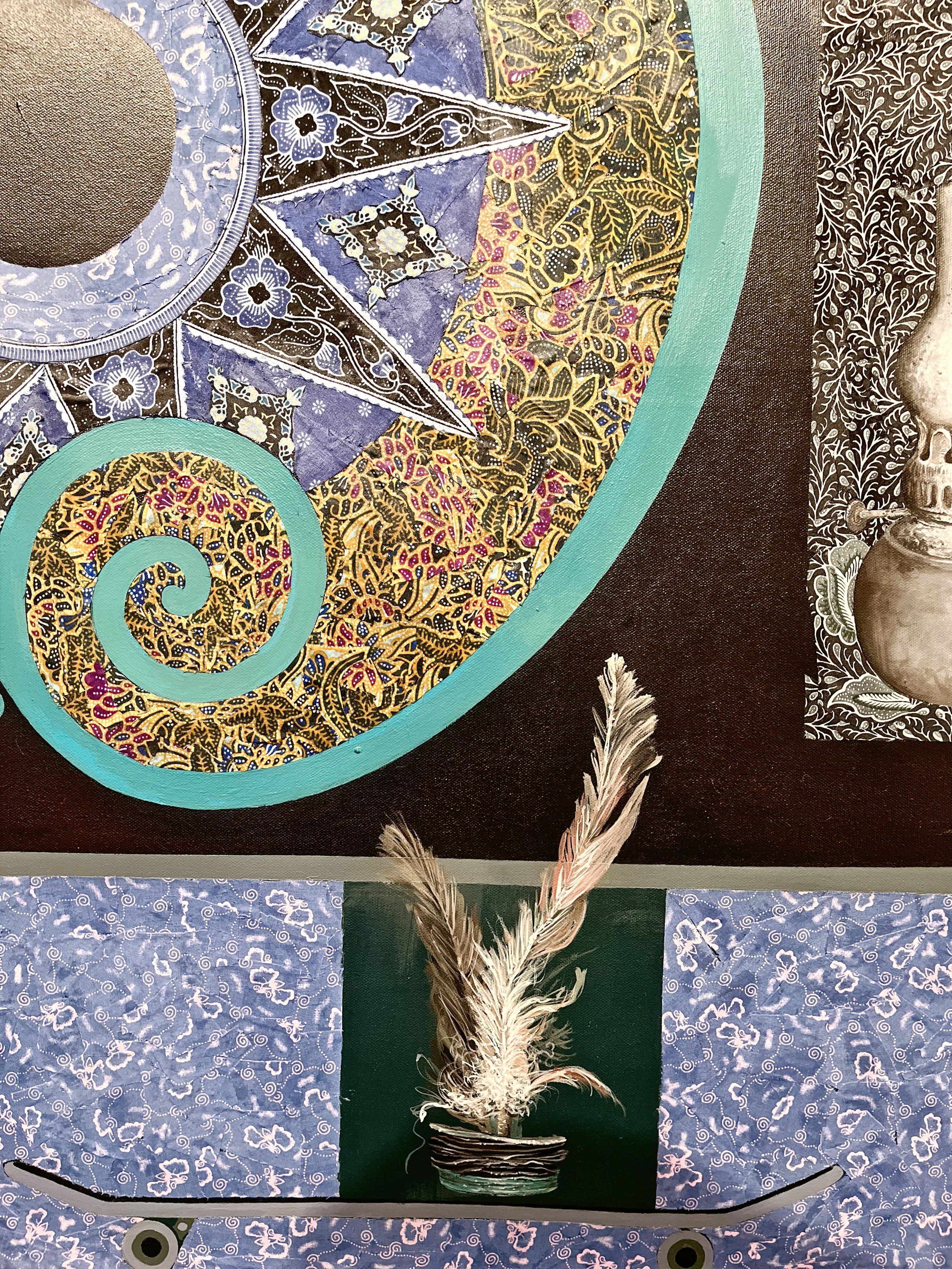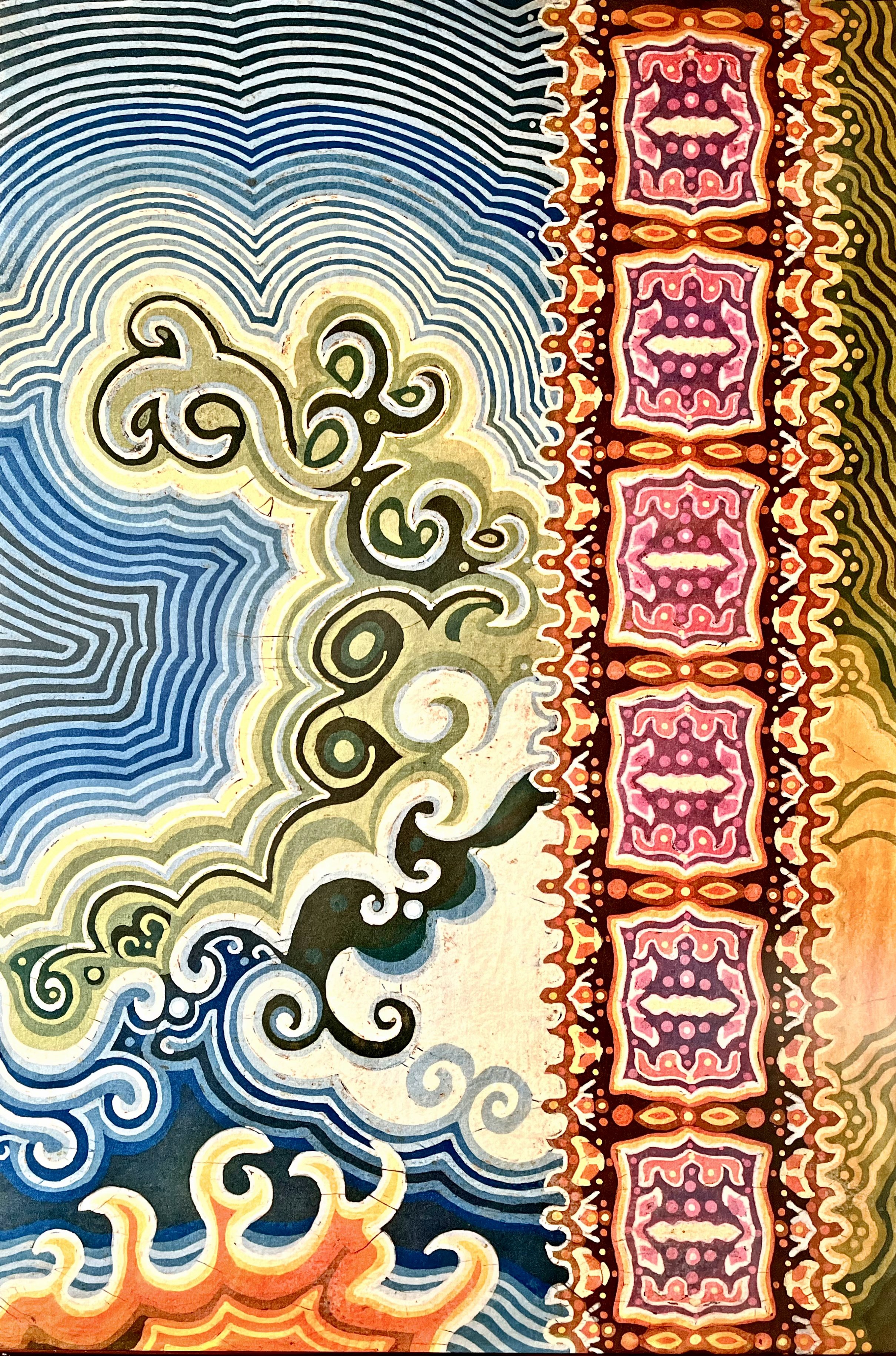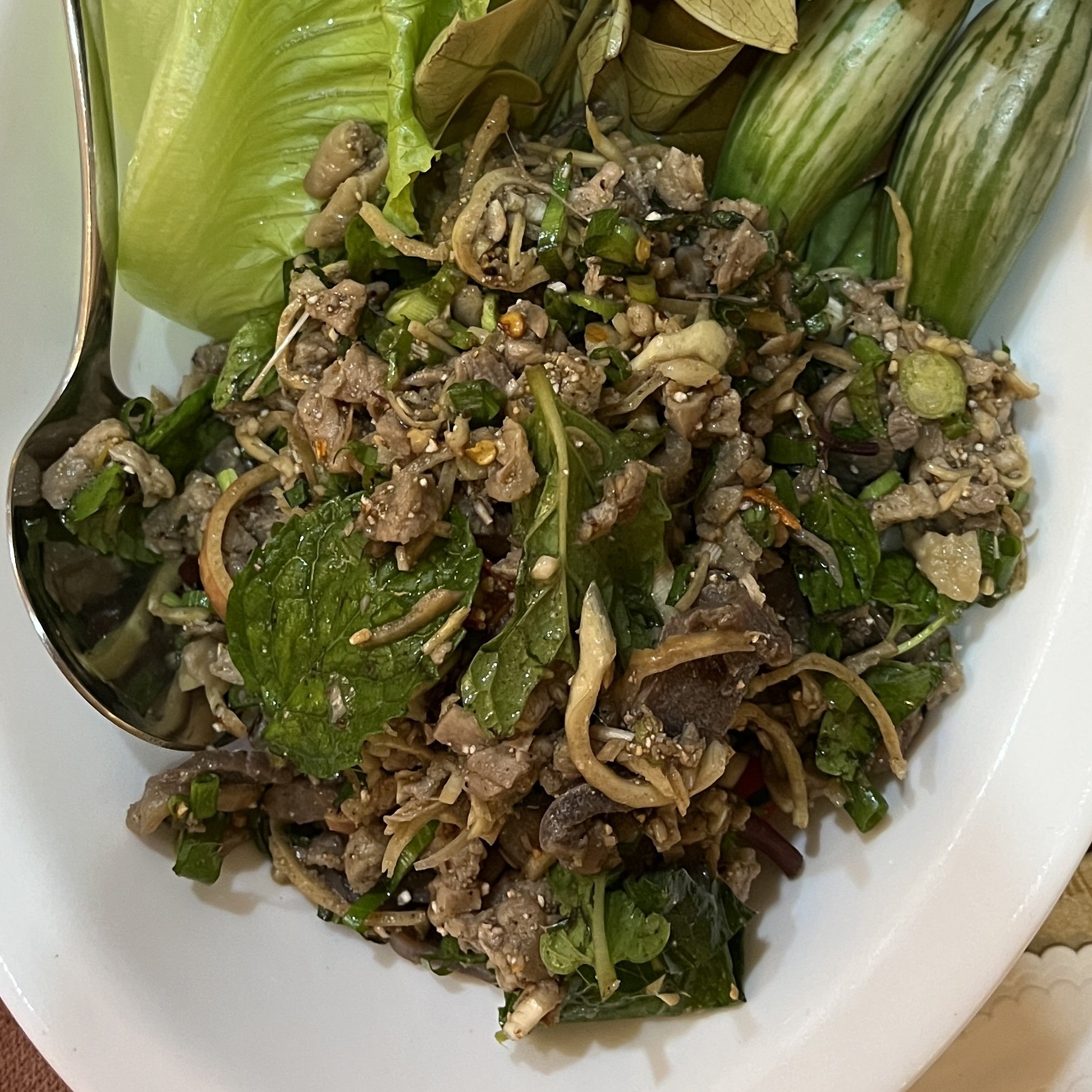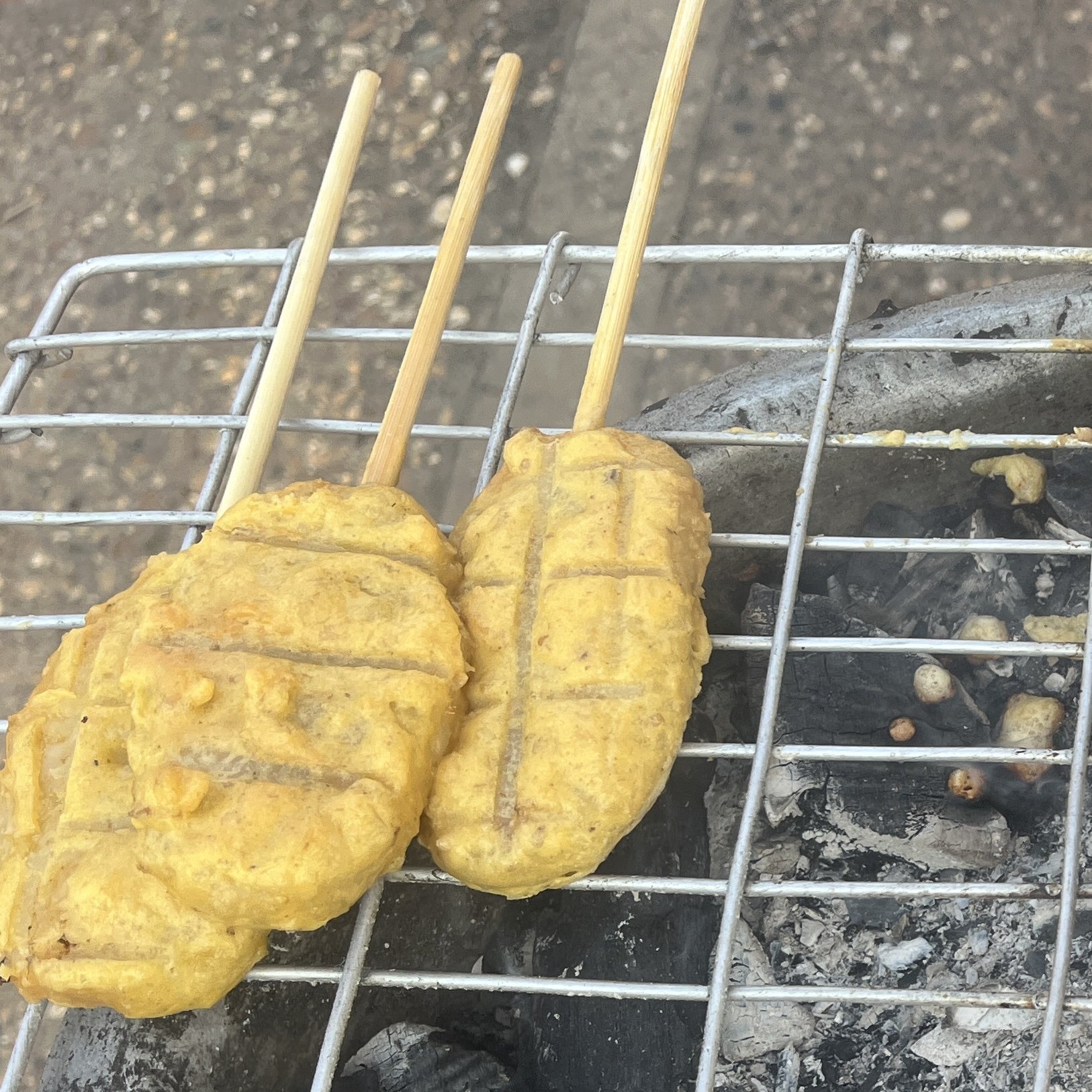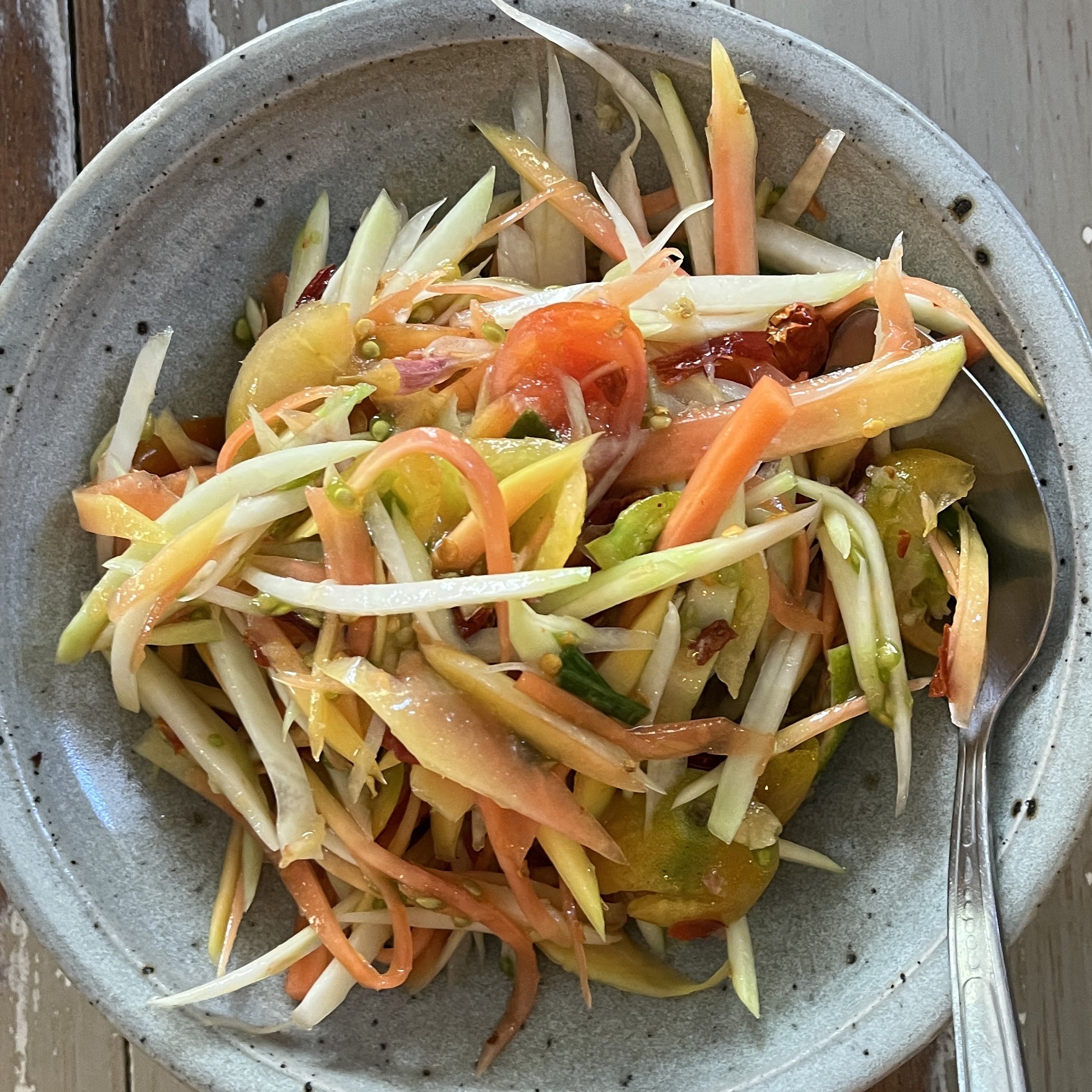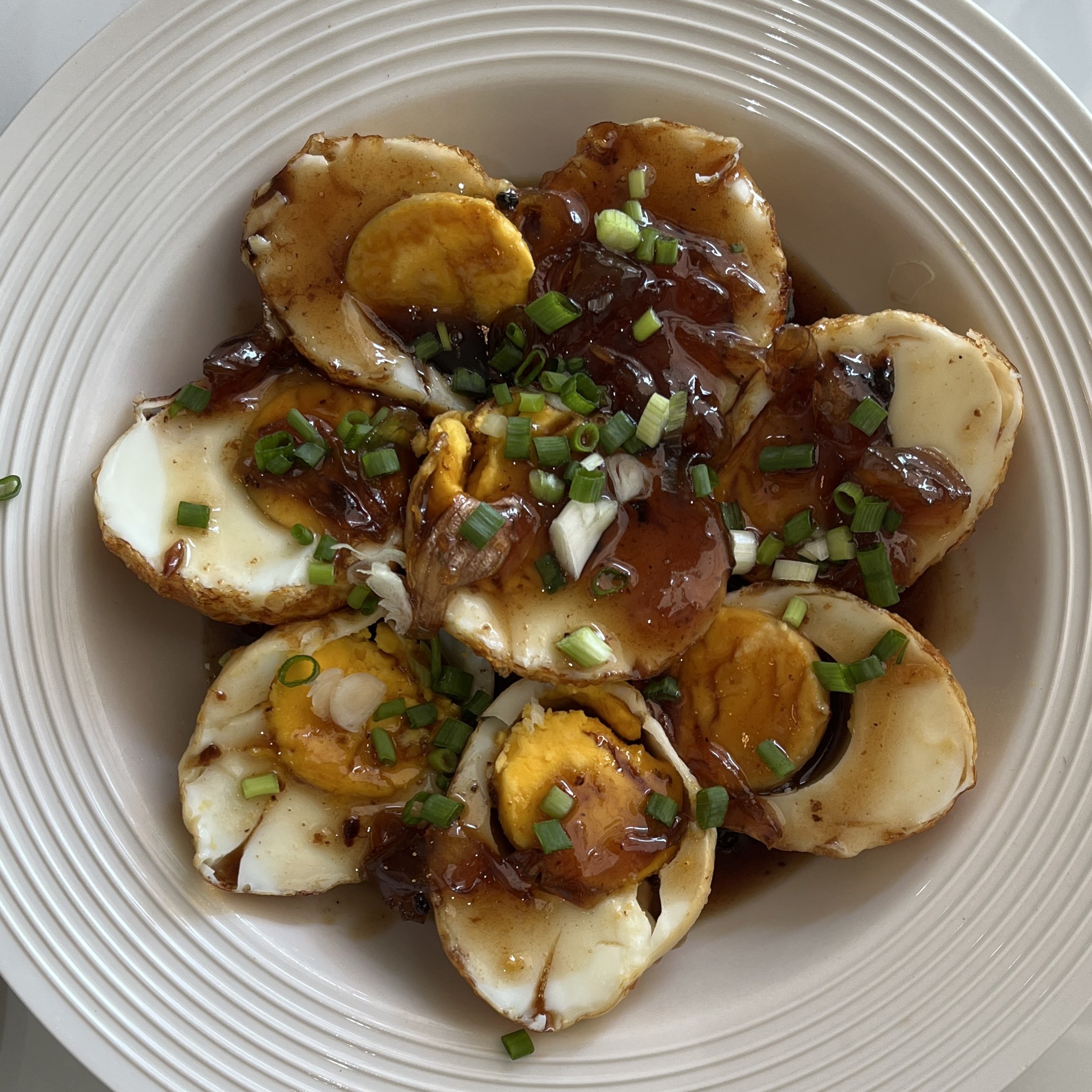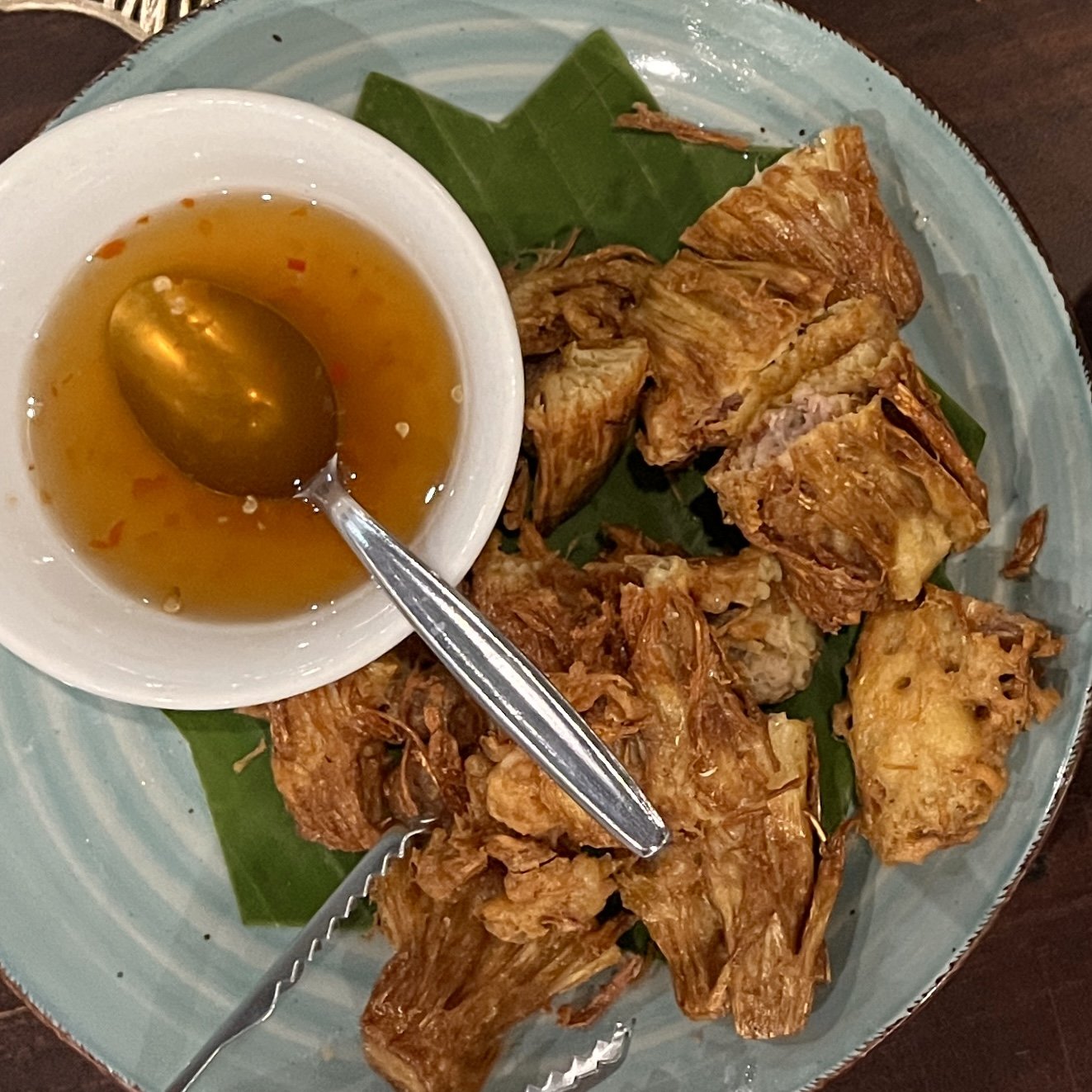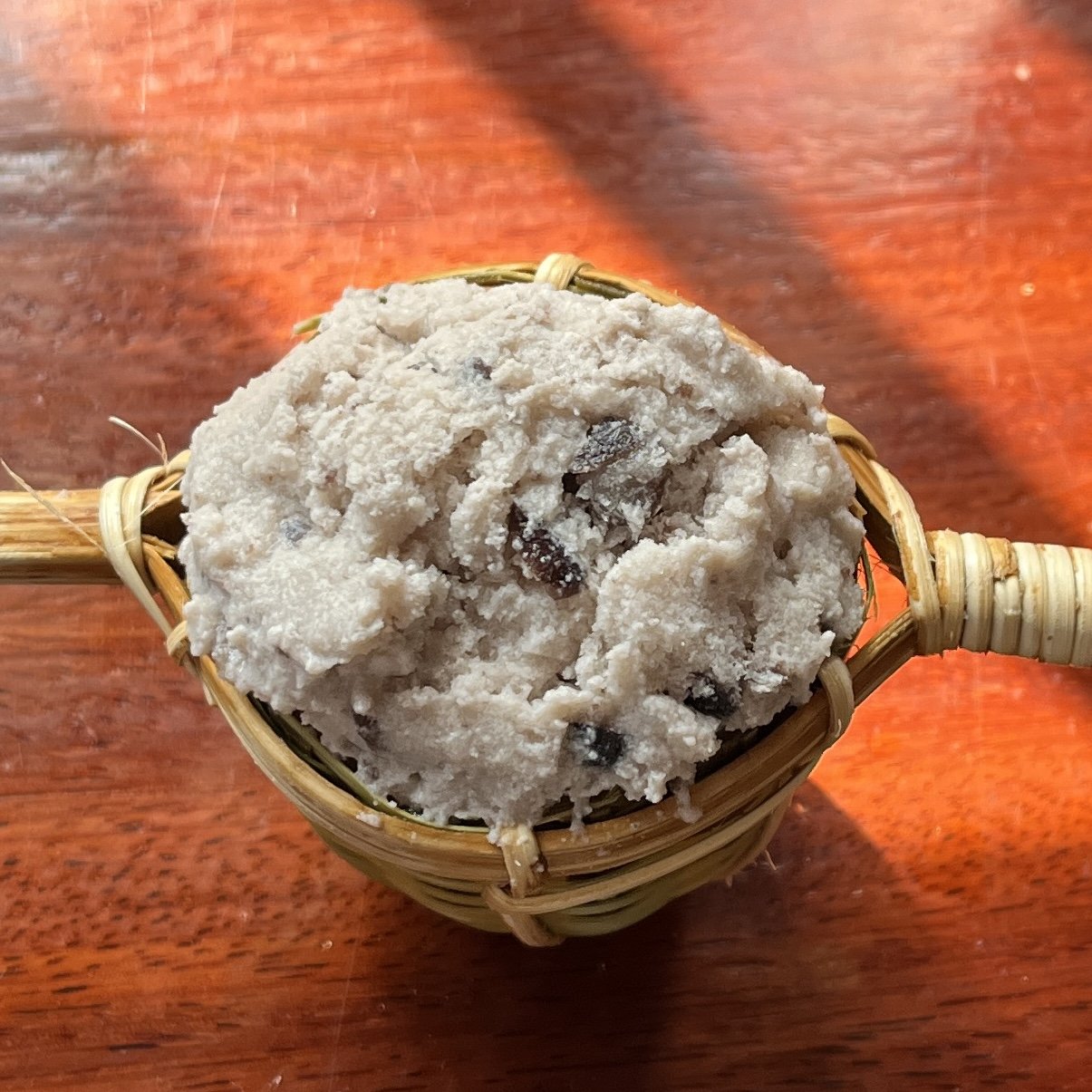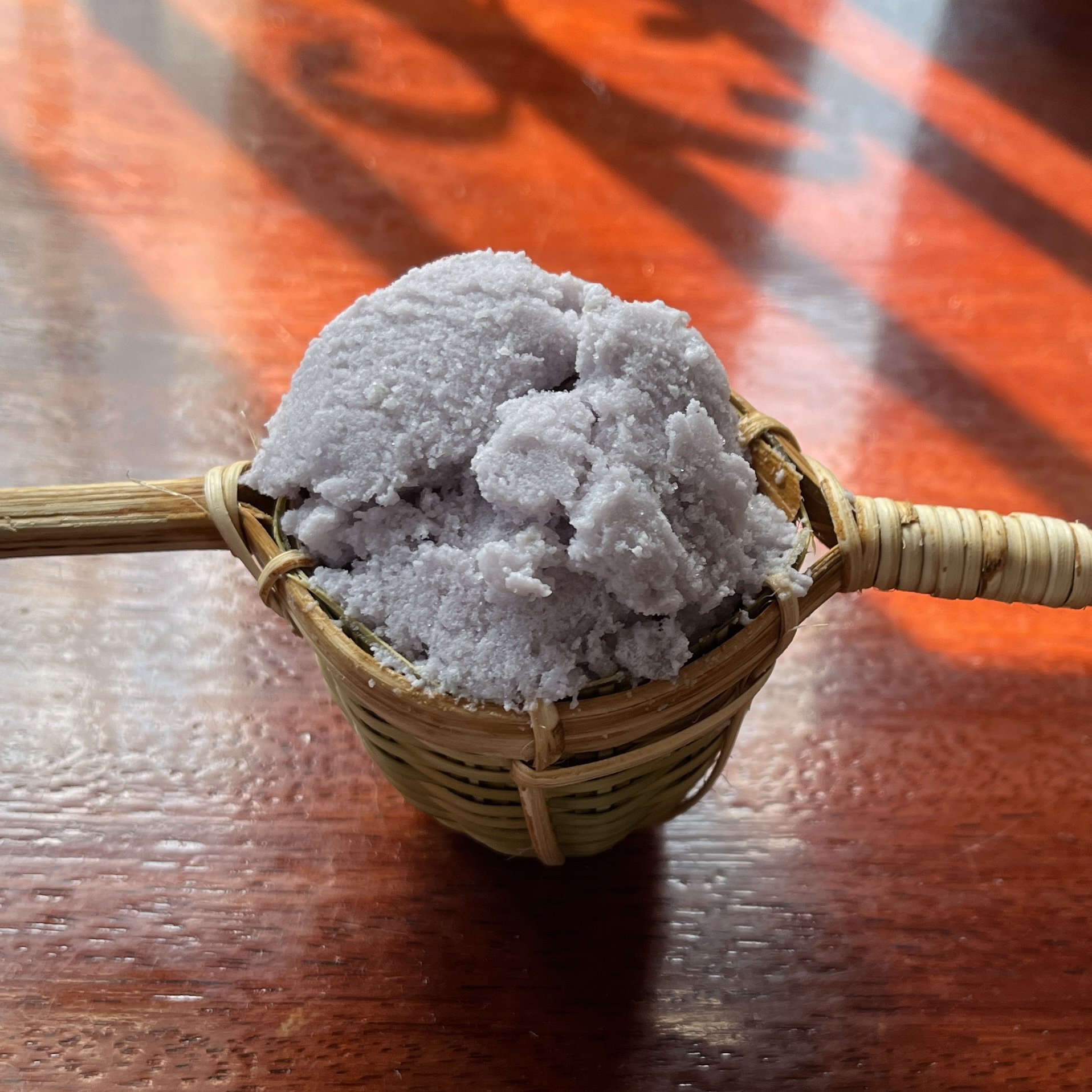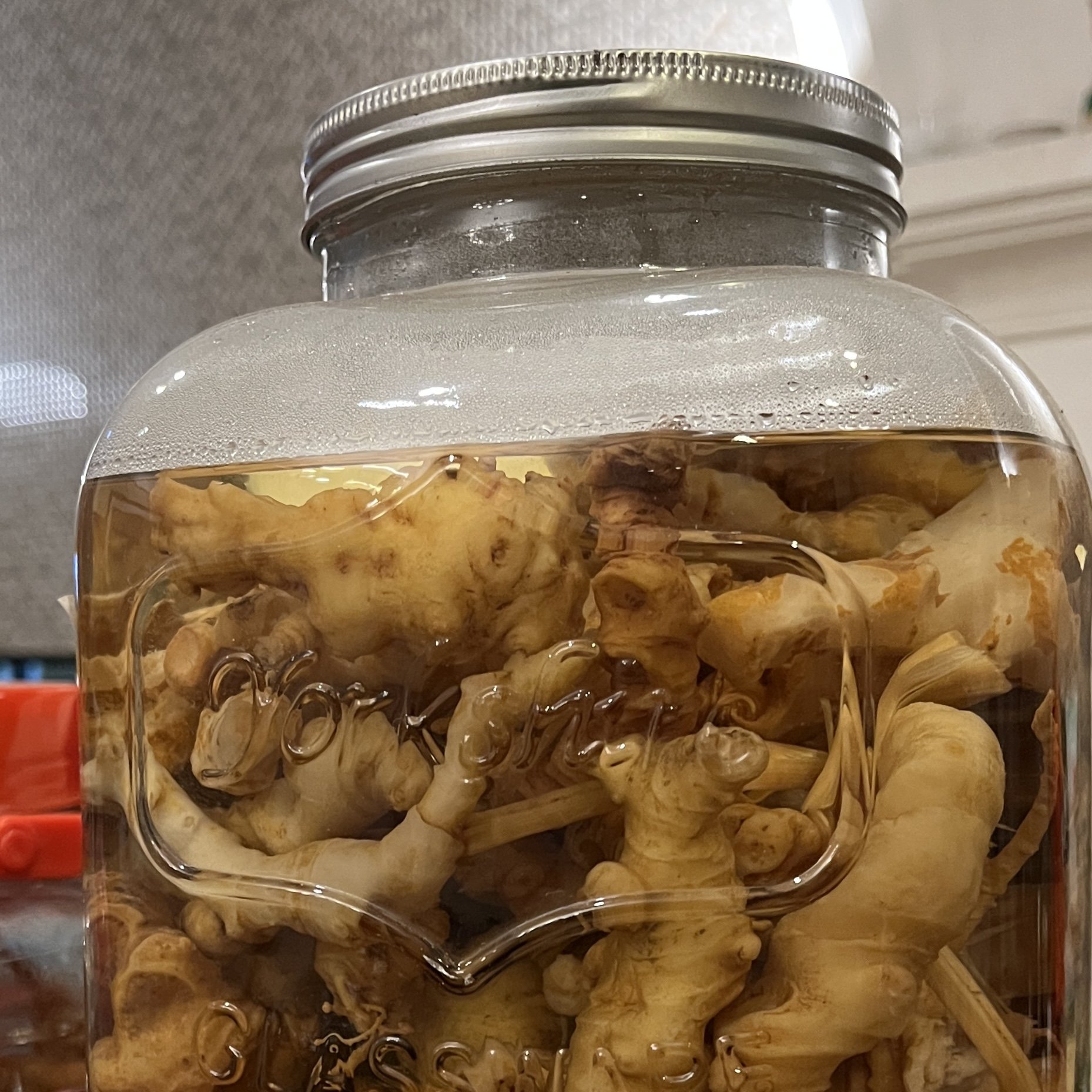My tuktuk driver wanted to pop into the market near Bakong village one day. Not much to say about it, just snapped a few photos.
Jahar Palace, Kota Bharu, Kelantan | Malaysia
Per wikipedia:
Jahar Palace was built in 1855 by Sultan Muhammad II of Kelantan for his grandson Raja Bendahara Long Kundor. The palace has a pentagon-shaped porte-cochère with the first floor balcony from which members of the royal family could watch ceremonies held in front of the palace. It was named after a jahar (flame of the forest) tree which was growing on the grounds at the time.
That’s . . . not quite right. A house was built caddy-corner to the 1844 Grand Palace (still used for official ceremonies, and not open to the public) in 1855 as the “flower making palace,” where precious silver and gold trees were made to pay annual tribute to Siam. In 1887, the current Jahar Palace was built directly in front of it.
The story of how Sultan Muhammad II came to the Kelantan throne is a little interesting: following his uncle’s death, he was one of three contenders. The first was King Treasurer of Banggul (Phraya Banggul/Phra Bidaksha) Long Jenal bin Paduka Sri Sultan Long Yunus, the oldest living brother of Sultan Muhammad I, already an old man and widely considered a placeholder until either the future Muhammad II (whom he considered his heir), or his main opponent, Raja Kampung Laut Long Muhammad (Tuan Besar) bin Raja Muda Ismail, came out on top. So, they dutifully started a war . . . but none of them took it seriously. 😂
In the book Kisah Pelayaran Abdullah Munsyi to Kelantan which was published in 1838 , Munshi Abdullah recounted the state of this civil war:
Every day, the King Treasurer's army will fire their muskets (guns) towards the King of Kampung Laut's fort. The king of Kampung Laut will then respond with only bullets from his own rifle. By noon, both parties were tired and hungry, so they would stop for lunch. The battle would then resume around noon for an hour or two, after which it was time for tea. A truce was called and both sides would cease from their battlefields and resume the conflict the next day. And the siege continued.
When Munshi Abdullah asked the elderly Long Jenal why he wasn’t really trying to win, for example by ordering a tunnel dug under the Kampung Laut fort and blowing it up? he replied:
"Ah, if I had done that, then I might have killed some people in the camp of the King of the Sea Village. You know, we know each other and our soldiers know each other. It would be impolite and improper to start a bloodshed in which both sides will suffer losses."
Eventually both sides applied to the King of Siam (Rama III) for help; Long Jenal was told to stay in Kelantan and quite literally hold down the fort; Long Senik was ordered by Rama III to visit the Governor of Songkhla, and told there he would be made Sultan Muhammad II of Kelantan; Tuan Besar was invited to Bangkok, and told by Rama III personally that he would have to give up his claims to Kelantan, but would instead be made the King of Pattani. Amusingly, Pattani already had a king, who was in turn shuffled off and made King of Jering. The transition process took around 5 years, with Long Jenal abdicating in favor of Long Senik in 1837 (when his reign as Sultan Muhammad II officially began) and Tuan Besar finally and fully packing off to Pattani in 1842.
Sultan Muhammad II was succeeded by his son Sultan Ahmad Tengah in 1886, who in turn moved into the Grand Palace and gave Istana Jahar to his own son and heir, Long Kundur, the future Sultan Muhammad III, in 1887. Unfortunately, Long Kundur was already quite ill, so his younger brother, the future Sultan Mansur, was simultaneously appointed Long Kundur’s heir and regent. Sultan Ahmad Tengah died in 1889, just three years into his reign; Sultan Muhammad III’s reign was even shorter, ending with his death, aged just 44, in 1891. Sultan Mansur lasted on the throne 8 years; not long, but not short in those days.
The royal family continued to use the palace as a residence on and off through the 1950s, but less and less after the more modern Batu palace was built within easy walking distance in 1939. Today, both palaces are museums housing various antique and vintage personal effects of the Kelentan royals.
The collection at Jahar Palace is far superior, with excellent examples of textiles, jewelry, household effects, etc. There’s also a large array of vintage weapons, some cars, some royal canoes . . . really a bit of everything.
I found the explanatory placards unsatisfactory, at least in English, but they gave me a jumping off point for keyword researching the things that interest me, like the different types of textiles.
The two checked textiles are punca patong cloth, so called because the end, or ‘root’ is cut off. It can be woven in either cotton or silk, and stripes and checks are the most common patterns. It is usually used as a sash by men and a kembang, or wrap skirt, by women.
Pelangi Cloth
Screen Batik
Punca Patong
Batik
Songket
Limar
The inside of the palace is very interesting, architecturally. The back house is in traditional Malay style, though quite large, even grand; the front house combines Malay and Western styles, with a pillared marble ground floor, and a wooden upstairs, subdivided with panels and carvings. It’s unfortunately a bit difficult to tell which ‘rooms’ are original, and which were constructed for ease of creating the usual boring exhibits found in Malay museums venerating the marriage and bedding ceremonies. It was clear to me that many layouts were unnatural; with so many brass pedestal dishes so placed, for example, that there is no room for people to sit and eat, forget walk about serving. Likewise, though I am unfamiliar with royal Muslim Malay marriages of a century ago, I presume the royal bedroom housed one beautifully carved bed, and there are currently three packed in side by side simply because the rest of the house has been filled with vitrines.
One thing I hated about the house was the preponderance of yellow polyester. I suppose it’s an attempt to cheaply imitate royal cloth of gold, though I doubt the house was originally decked in such a manner anyway, that’s a rather 1960s/70s new-money concept of ‘royal colors’ . . . it’s something I’ve noticed in multiple museums, and I hate it. I also don’t think it suits the very impressive woodwork.
I also sort of despised the staff here. The museum closes at 4:45, but they lied to me and told me it closed at 4:00, and started chasing me around at 3:00 telling me to hurry up and leave . . . they were also sitting at the entrance smoking and chatting, which is gross. I never want to smell cigarette smoke inside a museum. Still, the place is certainly worth a visit, and were I ever again in Kelentan I would go back.
St. Paul's Church, Christ Church, and the Dutch Graveyard, Melaka | Malaysia
Possibly the most popular tourist attraction in Malacca is the ruins of the oldest European building east of India, Our Lady of the Annunciation, built by the Portuguese in 1566. Annunciation was a rebrand that didn’t stick. St. Paul’s, as it is now called, was the name of the 1521 chapel demolished to build the current ruined church; the name of the church school founded there in 1548; and the name the Dutch kept when consecrating the building as a Dutch Reform church in 1641. The Bovenkerk (church at the top of the hill, ie. St. Paul’s) was deconsecrated when the Benedenkerk (church at the bottom of the hill, ie. Christ Church) was completed in 1753.
the view from the hill
Needless to say, Malaysians don’t visit for religious or cultural reasons. They’re there to take pictures of and against panoramic views of the city and straits beyond, always posing at the top of the stairs and in the windowless brick arches.
an obnoxious selfie taker
The more ridiculous among them pose among the propped up gravestones as well; there’s absolutely no sensitivity that this is a religious place of rest. They’d never permit behavior like this in a mosque or any type of Chinese or Indian temple, but persist in it here.
1952 St. Francis Xavier statue
St. Francis Xavier, a founder of the Jesuits and the greatest Catholic missionary in the East since St. Thomas, took his vows at Montmarte in 1534, and received the title deeds for St. Paul’s chapel in 1548. Having spent a decade establishing Christianity in Portuguese India, he used this church as his home base between missionary trips to Japan, the Maluku islands, and Borneo; he was the very first Christian missionary in each of these places.
He died on Shangchuan island in 1552, on a mission to Ming China. His body did not decompose much in its temporary grave there, and that was taken as a sign he was a saint. He was temporarily reburied for the second time at St. Paul’s, before being sent to Goa for permanent burial.
The open, caged-over burial vault is considered the one used for Francis Xavier, though there’s no archaeological or historical evidence to support the claim. People throw coins, flowers and money down through the grate, a rather Buddhist/Hindu way of honoring a Catholic saint; one is reminded that almost all converts of later Christian missions were Chinese and Indian, not Malay.
The apocryphal burial vault of St. Francis Xavier
Francis Xavier actually never received permanent burial; most of his body still rests in a crystal urn at the basilica at Old Goa; the rest was broken up into relics and sent to the churches he founded.
In 1614 (five years before he was beatified and eight before he was canonized), his entire right arm was detached. The upper arm was divided into two pieces, each sent to a Jesuit college; the hand and forearm were sent to the Church of the Gesù in Rome, where they remain (though they do go on tour)!
According to the Kristang (a local creole people also known as the Malaccan Portuguese), the right forearm of the Francis Xavier statue (installed in 1952 to honor the 400th anniversary of his final trip to Malacca) was immediately severed by a bolt of lightning, paralleling the removal of his real arm, surely an act of divine intervention . . .
the 1814 British lighthouse
Directly in front of the church is an 1814 lighthouse built by the British. It’s siting, though logical, must have seemed almost disrespectfully incongruous, even at the time.
The church as we now see it is in worse shape than if it had been left untouched. In 1930, Major CE Bone, the first president of the Malacca Historical Society, doubtless overwhelmed by boredom and curiosity, made several amateur, idiotic changes, including deleteriously repairing and rebuilding the old laterite brick structure with concrete, removing the dais and altar, unnecessarily excavating clearly marked tombs, removing all the tombstones and propping the prettiest against the walls, and repaving the floor. Looking at photos of the church from the 1920s and earlier, one wonders how he imagined his work was an improvement. Where is the large tomb to the right of the arch today, for example?
100 years ago v. today
Most of the tombstones are of Dutch East India company employees and their relatives. Life feels so short now, and whenever I read these I’m reminded of how much shorter it was then, particularly for women and children. I found it interesting that many of the names weren’t quite Dutch, French rather: Huguenots or their descendants who had fled to the Netherlands as anti-Protestant hysteria swept France in the 17th century.
Hereunder lies buried Reynier d'Dieu, in his life Chief Merchant in the service of the Honourable Company. Buried on the 17th July, 1655.
Here lies buried Theodorus Herbers. Died in the 9th year of his age, 18th April, 1659.
Hereunder lies buried Maria Noelmans, wife of Theodorius Zas, Minister at Malacca, who piously fell asleep in the Lord on the 14th March, 1660.
Three to whom Nature gave one house and joint dwelling now lie here together enclosed in this tomb. Died the 29th December 1647, and the 25th February and19th March, 1660. The " Gaffel-boyer " is our grandfather's first discovery. Our father's first house now closes our mouths. (" Gaffel-boyer "—an old-fashioned Dutch vessel.)
Here lies Emanuel du Moulin, in his life Head Merchant and Harbour Master in the State of Malacca, born in the year 1620 on December 5th, blessed by God and called closer to the lord on July 25th of this year 1660. (He was Harbour Master 1656-1660)
Hereunder lies buried Juffrou Maria Bort, who was the wife of Nicolaes Müller, Under-Merchant and Warehouse-Keeper here. Born at Amsterdam the 5th August, 1639, and piously fell asleep in the Lord the 25th August, 1661 aged 22 years and 20 days. (probably a daughter of Balthasar Bort, Secretary in Malacca 1646; Governor 1668-1679.)
The souls of our first son and daughter God took to Heaven's throne and left their bodies here below. Hereunder lies buried Daniel Massis the younger, born on the 21st June 1658, died the 19th February 1660, and Sophia Massis, born the 21st June 1664 and died the 11th November 1665. (probably the children of Johan Massis, Winkelier at Malacca in 1659 and afterwards Commandant at Perak and Ligor.)
Here lies buried Hendrik Schenkenbergh, in his life Chief Merchant and Second Personage of the Town and Fortress of Malacca. Died the 29th June, 1671. (He was Chief Merchant or Supercargo in Malacca 1668-1670.)
Here lies buried Balthasar Sonmans, only son of Mathaeus Sonmans and Johanna Rijcke. Born the 30th July, 1671 and died the 3rd of August of the same year. Here lies buried Johanna Rijcke, Wife of Mathaeus Sonmans, only daughter of Isaack Rijcke and Maria Bort. Born the 2nd February, 1655, and died the 25th January, 1673.
To the memory of Juffrou Johanna du Moulin, Wife of Heer Balthasar Bert, Councillor Extraordinary of India, Governor and Director of the Town and Fortress of Malacca. Died 17th March, 1676. Johanna du Moulin rests under this stone, whose immortal soul, when she had trodden this world's path just two months and two days less than twenty-three years, God came and bore away to its last rest. Submissive to God's will, she felt no pain in parting from the body.
Here lies beneath Joanna Six; born in Taiwan; housewife of merchant and commander of the fortress Jacobus Pedel, died January 1st 1696 at 40 years, 9 months 14 days old, likewise . . .
Here rests Constantyn Johannes Rooselaar, Son of the very honourable Heer Pieter Rooselaar, Councillor Extraordinary of India, also Governor and Director of this Town and Fortress of Malacca. Born, 13th July, 1703; died, the 18th January, 1707. As a balm for my former dear wife Sophia Huichelbosch, Heer Pieter Rooselaar erected this monument; born in Rotterdam on March 24th 1678 and died in childbed March 9th 1709. (Pieter Rooselaar was Governor of Malacca 1707-1709)
I do not speak Dutch, and most of the translations of the tombstone inscriptions in this post come from the 1905 book Historical Tombstones of Malacca, by Robert Norman Bland, available HERE FOR FREE from the Cornell University Library.
An invaluable record dating to before Major Bone ripped the place up, the book records the position of the tombstones in the church floor, provides translations (though somewhat flawed) of each and photographs of some, and a few additional photos of important nearby buildings (including À Famosa and Christ Church) as they stood at the time. I only photographed the tombstones I found the most aesthetically appealing, but there are many more.
from Robert Norman Bland's 1905 book, Historical Tombstones of Malacca
There is a more modern and complete guidebook reflecting the finds and changes of the last hundred years, the 2013 Historical Tombstones and Graves at St. Paul’s Hill Malacca by Dennis De Witt, a local Eurasian descended from the original Dutch and Portuguese families. It’s certainly not prohibitively expensive at rm 18, but I could not find it for sale in person at any of the hawker tables, or available from the publisher in eBook format. If I ever do come across it I’ll likely buy it, but presently cannot stay in one place long enough to arrange its delivery. I was able to read some helpful pages on google books preview.
from Dennis De Witt's 2013 book, Historical Tombstones and Graves at St. Paul’s Hill Malacca
from Dennis De Witt's 2013 book, Historical Tombstones and Graves at St. Paul’s Hill Malacca
Coming up against incomplete information, I found myself using google lens to translate some of the gravestones I had photographed. Interestingly, if set to ‘detect language’, they were not recognized as Dutch, but as Afrikaans. I suppose this is because Afrikaans derives from 17th c. Dutch dialects, while modern Dutch has standardized differently and evolved faster.
Maria de la Queillerie, wife of founder of the Cape Colony Jan van Riebeeck, was one of the aforementioned Huguenot descendants, the daughter of a traveling minister in fact, brought up in the Pays-Bas speaking both Dutch and French at home. Maria always sailed with Jan on his constant journeys between VOC outposts. She died of smallpox in Malacca in 1664, aged 35. Considered the ancestral mother of the Afrikaaners, a woman of inspirational piety and intelligence, her tombstone (though not her remains) was removed to Cape Town in 1915. A plaque on the floor currently marks her tomb, an odd exception to the rule at St. Paul’s.
Maria de la Queillerie
There are also several Portuguese tombs and their stones here. Most obviously predate the Dutch graves, though there was eventually some intermarriage between the Dutch and local descendants of the Portuguese.
According to Bland, Major Bone was not the first to move tombstones away from the earthly remains they were intended to mark; he writes regarding St. Paul’s: “It is probable that this became a favourite burial place with the Dutch when they had built their own church by the river, and that some of the earlier Portuguese stones were displaced by them. In one case it is clear that a Portuguese inscription has been obliterated and a Dutch inscription placed on the same stone. At a later date some of the early Dutch tombstones were displaced to make room for the burial vaults of a later generation . . . Most of the Portuguese stones have been moved to the church built by the Dutch and now used for the services of the Church of England [Christ Church].”
Sepulchre of Dom Miguel de Castro, brother in Christ, given by the next king in honor of Dom João de Castro, the captain of this fortress having died. (João de Castro, Viceroy of Portuguese India 1546-1548, was the lifelong best friend of Infante Luís, Duke of Beja. João died in 1548 and Luís in 1555. Miguel, João's son, was Captain at Malacca in 1573 and again from 1575 to 1577, sailing from Goa to retake the town from Aceh 3 times between 1573 and 1575, eventually succeeding. His tombstone appears to have been donated by Henrique, the Cardinal-King, Luís' little brother and the top recruiter of Jesuit missionaries to colonial Portuguese posts.)
Here lies Monsignor PETRUS of the Order of Jesus, Second Bishop of Japan. Died in the Straits of Singapore in the month of February, 1598.
S. de ANT° (ANTONIO) PINTO DA FONSECA, Commendador da Ordem de Sam Tiago (Sao Thiago), Provedor Geral (General) que foi das Fortalezas da India, Capitam Geral do Mar e Terra nas paragens do Sul. Falleceo aos 27 de Dezembro de 1635- Grave of ANTONIO PINTO DE FONSECA, Commander of the Order of St. James, Provedor-General of the Fortresses of India, Captain-General of the Sea and Land in parts of the South. Died on the 27th December, 1635.
Francisca Barber, most pious wife of Captain Jacob Barber. She was already pregnant when she went from the isle of Bombay to China, accompanying her husband, and about to depart tomorrow from the banks of Malacca, where her pregnancy (to the great dismay of the hospitable Dutch people, who dedicated themselves to preserving their guest's life) became fatal; she succumbed in labor before being delivered of her fatal burden. September 10th 1695.
Around the back of the church outside, trailing down the hill, are 19th century British graves. It’s more than a bit horrifying how hawkers cling to them.
pointlessly bricked up and cemented windows
trash can etc. too close for comfort to an old British grave
There’s an outdoor stair leading down to the Dutch cemetery, past a continuous complex of abandoned British colonial buildings, including what was once the Resident’s house (and then Governor’s Museum) and its outhouses to the left, and to the right Kampung Tetek, Malay houses backing onto neglected British tombs. The Residency seems to have been a functioning museum as recently as 2 years ago, but is now closed.
another needlessly closed museum; more British graves line a closed walkway down the hill to the Dutch cemetery.
It appears to be old worker housing?
beautiful old offices or housing
atop this old British tomb, in the corner by the local houses and closed walkway, are lots of empty plastic drink bottles etc. the disrespect . . .
The stair should open onto Jalan Mahkamah, between Dutch shopfronts to the left and the Dutch cemetery to the right. Unfortunately, it’s been closed off for no discernible reason, so you actually have to walk all the way down and around the hill in one direction or the other to visit the Dutch cemetery. A plaque on the Dutch shopfronts commemorates their gazetting as landmarks in 1988, but they seem to have been abandoned for a minimum of 15 years.
Should be orange, not purple?
The Dutch graveyard was used for Dutch burials between 1670–1682 and British 1818–1838. There are only 5 Dutch monuments and 33 British; it is believed that the British moved Dutch tombstones up to the ruined St. Paul’s, though I’ve found no evidence or testimony of that.
This c. 1678 tombstone for a couple is written in Dutch, but the wife is named Magdalena de Costa, indicating she was at least partially Portuguese, possibly descended from Afonso Lopes da Costa, who was Captain of Malacca in 1519. The motto below the seal reads 'Christ is my hope.'
The obelisk is for White and Harding, two mid-twenties naval officers who died in the short-lived War of Naning (August 1831 - June 1832). It was less a war than an uprising led by Dol Said, the hereditary chief of Naning, who didn't want to pay the 10% flat tax on produce imposed by the British on all Malaccan vassal states. Needless to say, the British won.
This tomb sparked my curiosity about the Millers of Monk Castle. Monkcastle was first attested in 1536 as the administrative centre for the north-west portion of the extensive estates held by the monks of Kilwinning Abbey. The estates passed in the mid-1550s from Church to commendator, at that time a Hamilton. The building was recorded as a “pretty fair building, well planted” in the first years of the 17th century, but a ruin by the end.
the ruins of Monkcastle, kept in more or less their current state since 1895
The ruin first came into the Miller family in 1723, and Alexander William Miller, the father mentioned on Janette’s gravestone, built the extant and occupied Monkcastle House nearby circa 1820, so halfway through her short life. It was probably designed by the architect David Hamilton, a descendant of the original commendators now best known for Nelson’s monument and the Royal Exchange.
There was a serious fire at Monkcastle House in 2016.
Said father was not a member of the EIC, and predeceased this daughter by three years, so I find it interesting that only he is mentioned on her tombstone, not the intended husband or perhaps other relative(s) she must have travelled to Malacca for, or older brother/family scion who must have paid for it.
In Memory Of
DAVID MUDIE, Midshipman,
Third Son of JAMES & JANE MUDIE
Of Pitmuies, Scotland
Who Died On His Passage From Bengal To China
On Board The H.C.S. Vansittart,
On The 12th August 1831,
Aged 17 Years
All The Flesh Is Grass & All The Goodliness Thereof
As The Flower Of The Field The Grass Withereth, The Flower Fadeth
But Even The Word Of Our God Shall Stand Forever,
As In Adam All Die, Even So In Christ Shall All Be Made Alive.
This one just seemed so sad because he was so young. No matter what happened, passing on a wooden boat between Bengal to China is a hard way to go for a very young British person.
Walking around, I often wondered about the clusters of people who died within a month or so of each other, throughout the centuries. Were they on the same plague-ridden boat? In the same jungle battle? Victims of the same local malarial outbreak? All the flesh is grass, indeed.
Perak Museum, Taiping | Malaysia
Taiping is not a place worth visiting, in my opinion; one of its few somewhat redeeming sites is the Perak museum, Malaysia’s first and oldest museum. Founded in 1883 by Sir Hugh Low, its initial focus was natural history; particularly zoology, geology, botany, and ethnology. The big-statue-of-a-white-man-needlessly-relocated-to-a-disrespectfully-insignificant-corner (a cliché in resentful former European colonies) is not Low, however; nor is it Sir Frank Swettenham, the majority fundraiser for the museum and arguably the most eminent Brit in colonial Malaysia (Resident of Perak 1889-1895, Resident-General of the Federated Malay States 1896-1901, Governor and Commander-in-Chief of the Straits Settlements 1901-1904). Rather, it is Robert Sandilands Frowd Walker, curiously bylined on wikipedia as a ‘football player,’ despite his very successful 30+ year career in the British colonial army.
Walker attended Sandhurst; served in Gibraltar, Malta, Hong Kong, Singapore, and accompanied his superior for the investiture of King Chulalongkorn in the Order of St. Michael and St. George, all before landing in Perak; molded Perak’s police force for over 20+ years to a high military standard, keeping relative peace among the Chinese gangs during the mining boom; and eventually rose to Resident of both Selangor and Perak. When crime was low, he put his police force to work building out the Taiping Lake Gardens; he also raised enough funds to ensure a clergyman always presided over the local All Saints’ Church. He was a Fellow of the Royal Geographical Society, the Royal Zoological Society, the Royal Colonial Society and the Royal Colonial Institute. He commanded the dismounted colonial troops at Queen Victoria's Diamond Jubilee in 1897, and laid the foundation stone of the Diamond Jubilee Wadda Gurdwara Sahib at Penang. His nickname among local Malays was “the black panther”; Chinese feared his Perak Armed Police Force of “Sikh devils”; fellow Brits described him as "at the best of times very much a martinet" and "a difficult man to work with.” . . . . yet, above all, he is apparently remembered for scoring the winning goal of an England/Scotland match at 21, and introducing cricket and football to the locals in the areas he governed.
Though it’s not much of a present-day practice, this museum is still where taxidermy is taught and practiced in Malaysia. Considered a target unworthy of bombing in WWII, galleries upon galleries of dryrotted and peeling creatures of all types, many now endangered and some extinct, most preserved by Low and his team 150 years ago, remain. I only took a few photos because I find them macabre (and their circa 1990s or early 2000s photo mural backgrounds tacky) but these make up the majority of the museum.
Doubtless to my discredit, I find the artifacts of local material culture much more beautiful and interesting. There is impressive metal and enamelwork, century old Chinese wedding robes with incredible embroidery, vintage and antique Malay gold-wrapped thread embroidered red velvets, songket and other traditional fabrics.
There are also some artifacts from the Negrito native people, mainly basketry but some masks and other objects.
Finally, there’s a very small library, which consists mostly of books in English (though there are some in other European languages) dating from the colonial era, clearly left behind by the Brits. The most recent items are science periodicals for children from perhaps 30 years ago. Hours are posted on the door, yet when I entered there was no worker present and all the bookcases were locked up. Within perhaps five minutes, a woman entered in a huff (obviously alerted to my presence by some security guard) and announced that the library was by appointment only and I was not permitted to look at or touch anything. That’s not what the sign says, not what the website says, and I have found no proof anywhere that this is true.
I asked if there was a collection catalog to peruse in advance of making an appointment; she claimed there was not. I asked if the books had been digitized and published online . . . they have not. Perhaps she has other responsibilities, but it very much seems the negligent oversight of her superiors has allowed her to reduce her job to sitting around on her phone in silence, and she’s come to expect so few visitors that she prefers to do so in the air conditioned employee cafeteria rather than the library itself, which they don’t bother to cool.
Outside, there are vintage luxury cars that I guess were purchased for heads of state at some point. There are also examples of early public transportation, including small buses and railcars.
Across the street is the water company office, still in its the original wooden building.
Beyond the museum, one can see the green-shuttered colonial jail, which I was shocked to find is still in use, hence the oddly covered-up fence.
A fifteen minute walk down the street reveals this was the main drag of the colonial era; All Saints’ Church and the Officer’s Club are easily reachable by foot (despite them not bothering to build sidewalks), and a couple other closed up colonial buildings are along the way.
Chinpracha House, Phuket | Thailand
On the outskirts of Phuket town, Chinpracha house is “thought to have been built”* in the third quarter of the 19th century, described in Thai sources as “in the final years of the reign of Rama IV” (Rama IV ruled from 1851- 1868). *This is the phrase used in all sources, as if the family doesn’t remember or can’t locate any records. In my opinion, perhaps an original house was built here in that era and later renovated beyond recognition, reaching its final form 20ish years later. Thais in the area who pride themselves on their Peranakan heritage insist on calling this sort of hodgepodge Victorian architectural style ‘Sino-Portuguese,’ though the Portuguese had been driven out of Phuket well over 200 years before construction began. Perhaps when I make it to Portugal I’ll change my opinion, but stylistically it looks to derive much more directly from the European-fantasy type palaces built by Chulalongkorn (Rama V) in the 1900s and 1910s.
Directly translated, “Chinpracha” means “Chinese Mr. Chua,” which makes me chuckle- they obviously didn’t take choosing a last name too seriously when the 1913 surname act came into effect and many locally-born Chinese felt socially pressured to assume more Thai-ethnic-sounding surnames. The lady of the house (an 80 or 90 something grandma) still lives upstairs, and her grandson and other family members lead the 150 baht tour around the house, and are happy to answer questions to the degree their quite decent English allows. Downstairs is a museum stuffed with all the family’s old furniture, most of it imported from China and Europe at doubtless great expense. Unlike many other museum houses I’ve visited, everything is their old stuff, not antiques bought secondhand and packed inside to create a cash-cow “museum”. They can talk about their old tin business, import-export business, liquor licenses, political influence etc. in some detail, and that history is reflected by the stuff they held onto.
Downstairs is a little café where they serve very basic snacks and drinks, and they have rental costumes if you want to dress in the Peranakan style and do a little photoshoot at the house. Right next door is a blue elephant cooking school in another, slightly younger, old mansion; if I had a bit more money at the time I visited I might have eaten something or gotten a drink there just to check out the interior. It’s also very close to the Michelin bib gourmand Charm Dining Gallery, a much better place to eat. For my final note, I did seek out and watch the old Oliver Stone film Heaven and Earth, which this house served as a set for certain scenes of . . . I enjoyed the house visit, but don’t bother with the movie!
Michelin Meals in Penang | Malaysia
Due to inescapable shitty circumstances, I’ve spent way more time in Penang than I ever wanted to, probably 2 months altogether. Eating is the main activity in Penang, and I’m always interested in trying Michelin mentioned restaurants, because it feels like a safe way to stretch my palate into cuisines I’m unfamiliar with. I only bother with places that get stars or a bib gourmand, and I’m not a completionist- if I have to eat a meal anyway, have the money, and it’s closeby, OK. Otherwise, don’t care. I also prefer to focus on local, traditional food; I have been and will return to Thailand and India, for example, so there’s no reason for me to eat Thai or Indian in Malaysia. Anyway, these are the Michelin rated restaurants I visited in Penang, ranked from most to least favorite.
Sardarji
Yes, I know I just wrote I can eat Indian food in India. However, I would be amiss to not put Sardarji’s first simply because when I’m in Penang and don’t feel like going out, the takeout special below is what I always order to my hotel. It’s reasonably priced at under rm 30 (it would be under rm 20 with plain rice instead of the cheese naan I prefer), and I typically stretch it out into three meals with chopped fresh white mushrooms and side biryani rice. Many famous restaurants in Penang only serve good food in their dining room, sending the scraps and mistakes out for delivery orders. Sardarji’s has always been tasty and consistent.
dhal, buttermilk salad, aloo ghobi, cheese naan
Dal Makhani
Fish Korma
Salt Lassi
Rasa Rasa
The menu at Rasa Rasa is simple- classic Malaysian lunch sets and some Thai dishes. The food was fresh and tasty, the owner was kind, and the space is small and straightforward. Nothing sophisticated but would definitely eat there again were I in the neighborhood.
Bihun with Sambal Prawns
White Coffee
Communal Table by Gēn
I had two different experiences at Communal Table; one excellent, the other not so much. The first time I visited was nothing short of fantastic, the best meal I had in Penang by far; I walked in and did the tasting menu (which apparently is the same for lunch and dinner) and almost popped the food was so delicious. Every item on the menu was something I would never have chosen for myself, but was incredibly impressed by- the chicken heart, wingbean salad, and claypot ulam rice were all standouts. There was nothing I didn’t like, or found insufficiently nuanced. Every dish was perfectly balanced and delicately plated. I also tried a shot of tuak (Malaysian primitive rice wine) and its sparkling version, which were certainly not my favorite wines ever, but I would absolutely try again. I suspected at the time and have confirmed in retrospect that I was being served by the founder, so the cooks must have been doing their absolute best.
My second visit was about 3 months later: I walked in for lunch and was turned away for arriving too late (google maps hours say 3pm but their last seating is apparently 2pm); I was told to make a reservation for the next day. I did not because, frankly, having eaten there already, I was indifferent to whether or not I ate there again- happy to have a decent meal, happy to move on and try somewhere new, depending on where I found myself at lunchtime. I did walk in immediately upon their opening, and was scolded! The waiter said “We really only take reservations for lunch, I remember you from yesterday” and acted like it was a big deal to accommodate me despite the place being near-empty and me being a party of one. I had checked their online reservation system just an hour prior and seen free slots for literally every half hour from opening to closing, so while I appreciate they may purchase ingredients daily based on reservations, there was no reason to pretend they were making a huge sacrifice by serving me during a very slow lunch hour.
When seated, I asked for the tasting menu, which looked to have changed since last I was there, and was refused, told it was too much food for me . . . sigh. My mother died of complications of ulcerative colitis. My uncle died of kidney failure. I’m getting a gastroscopy myself in literally 3 days and obviously not looking forward to it. As long as I am in good enough health to eat and drink the best, and whatever I want, in large amounts, I intend to. Unless CTbG had not bought a single extra serving’s worth of ingredients for the tasting menu, and planned on turning away everyone who did not make an advanced reservation, even come dinnertime, I should have been served. I ordered à la carte instead, and it was not great. The local oysters are bland compared to the American oysters I grew up with; the stingray cracker tasted old and had lots of bony bits; the stinky tofu wasn’t stinky. The chef’s pouring, orange wine from Spain, was terrible in my opinion, yet inexplicably popular in Penang, popping up at several restaurants. They didn’t have any tuak, so I tried a local beer, which was forgettable.
It’s fair to say Communal Table is still overall high quality and shows some imagination, but expensive and inconsistent . . . and I don’t really want to pay $75 for a hit-or-miss lunch with bold waitstaff.
L: Golden Pomfret R: Chicken Heart
Pork Skewer
Chawan
Wingbean Salad
Claypot Ulam Rice
Barramundi
“Banana Cream Pie”
?! I don’t remember, it was only for that day’s tasting menu
Penang Oyster
Stingray Cracker
Stinky Tofu
Hazy NEIPA
“Sweet Corn” dessert
Penang Road Famous Laksa
Serving up the old school classics to hundreds of locals and tourists daily, this place sort of sets the standard for what penang laksa is. Assam means sour, and the broth is sour and sweet and herbal. I liked it, didn’t love it, but would have no problem eating it again. The char kuey teow was a bit too greasy and bland for me; I can’t help but wonder how these greasy spoons get Michelin bib gourmands in SE Asia. It would be like giving every half-decent suburban American diner a Michelin nod. The omelette was unexpectedly excellent- I was really surprised by it. I’d go back for the omelette. The softshell crabs are sold by a streethawker who goes around into all the restaurants with her snack menu. They could use more seasoning- salt, pepper, salted egg yolk- but were still crunchy and a good snack for walking around, coming in a plastic cup. The nutmeg juice is a local classic: I love a refreshing sugary juice once in a while.
Penang Assam Laksa (sour and spicy fish broth with lemongrass, galangal, chili, thick rice noodles, onions, mint, pineapple, strong and sweet prawn paste, and ginger flower)
Char Kuey Teow (eggs, bean sprouts, chives, shrimp, sliced fish cakes, fried with flat rice noodles)
Amy’s Famous Omelette- half oyster, half shrimp
Fried Small Softshell Crabs
My own café
The simplest menu, the cheapest food, the emptiest restaurant at lunchtime . . . I have no idea how this place survives, but the Assam Laksa and Durian ice coffee were excellent and I’d happily go back anytime.
Penang Assam Laksa
Durian White Coffee
tho yuen
Bibik’s kitchen
Bibik’s was the first nyonya food I ever ate. She is an overbearing auntie (Bibik literally means “auntie” in Malay), and the service is impeccable. The food is on the mild/sweet side. The standouts are the kerabu salads, jiu hu char, and hot nutmeg drink.
Rose Apple Kerabu (rose apple, cucumber, shallots and torch ginger, dressed in lime juice and sambal belacan)
Udang Masak Nenas (mild shrimp and pineapple curry)
Jiu Hu Char (shredded jicama, finely-julienned dried cuttlefish, carrots and pork, topped with spring onions)
Loh Bak (5-spice marinated pork wrapped with bean curd skin and deep-fried)
Butterfly Pea Flower, Pandan, Lemongrass and White Rice
lemongrass is my personal fave
Bubur Cha Cha (taro, sweet potatoes, bananas, sago, beans in a lightly pandan-flavoured coconut milk base)
Nutmeg drink
Ivy’s Nyonya Cuisine
The menu here was extremely limited and classic, mostly intended for large parties. I didn’t love everything- the barley drink, fish maw soup, and sambal hae bee were interesting, but I doubt I’ll ever eat them again. The kapitan chicken, assam seabass and bee koh moy were wonderful, with more interesting and complex flavor profiles than others I’ve tried. On returning to Penang a second time, I forgot about Ivy’s, and I think it’s because of the really boring interior. The elderly owners are understandably tired of running around and have purchased one of those Korean robot waiters; it was my first time using one. I don’t mind but obviously can’t call it a warm or luxury experience. They have a bit of memorabilia in a couple display cases, but nothing I’d call décor. I’m not sure I’ve ever forgotten good food before due to lack of a memorable aesthetic, so Ivy’s may be the first. The set dinner is a good deal and worth a visit.
Sambal Hae Bee (dried spicy shrimp)
Kapitan Curry Chicken
Hoo Pioh Th’ng (fish maw soup)
Jiu Hu Char
Steamed Seabass in Nyonya Assam Sauce
Barley Tea
Lime Juice
Bee Koh Moy (black glutinous rice porridge topped with coconut milk)
Green House Prawn Mee Corner
One of those small super-cluttered shops catering to local and tourist Chinese, I was really unsure what to order, so I asked them to give me whatever they were famous for. I ended up with classic Hokkien prawn mee, which they served with a mix of bihun and egg noodles, rib tips and a tea egg. It was tasty and satisfying in a very basic way, but I wish I had gone for the mix with law mee. Odds I’ll ever find myself on that street and hungry seem low, but you never know!
Hokkien Prawn Mee
Auntie Gaik Lean's Old School Eatery
This restaurant has the distinction of being awarded 1 Michelin star, so not just a bib gourmand. I suspect it’s rather more due to the location and clientele (diplomats, business tycoons and visiting royalty on special occasions; local investment bankers and hoteliers and their families most days) than the food. According to the owner/chef’s son, the deciding dish for the Michelin reviewer (who I thought were supposed to maintain strict anonymity?) was the nasi ulam, the herbs for which his granny and auntie climb the mountains in the early morning or some such . . . I appreciated it in a sort of academic sense, but wouldn’t bother going back for it. The flavors of the fish curry were disappointing to me, as was the cold nutmeg juice. The pie tee were tasty but unremarkable.
I have a terrible habit of walking in without a reservation, and in SE Asia this means usually getting seated at a communal table with fellow seat-of-our-pants fliers. The evening I visited Gaik Lean’s was spent in the company of a variety of ethnically Asian (northern mainland Chinese, Japanese, native Singaporean) Singaporean bankers, who happily shared the dishes they ordered with me and provided their rather more informed perspectives on the food. I felt too awkward photographing them, but did have assam prawns and kapitan curry chicken at their behest. We all agreed: terribly anti-climactic.
Pie Tee (crispy pastry tart shell typically filled with a spicy and sweet mixture of shredded Chinese turnips, thinly sliced vegetables and prawns)
Nasi Ulam (cold rice tossed with local shredded herbs and spices)
Gulai Tumis (Tamarind Fish Curry)
Cold Nutmeg Juice
Duck Blood Curry Mee
After getting the Michelin nod, this place cheaped out and substituted cheaper, less smooth pork blood for duck blood . . . so annoying. I didn’t know what to order, so told the owner to serve me whatever they were famous for; you can be the judge of the mix photographed. Pork belly and blood gelatins are challenging foods for me, things I’m willing to give a shot because of Michelin but wouldn’t otherwise. It was tasty enough, and the giant bottle of beer didn’t hurt. I probably wouldn’t go back, but I enjoyed trying.
Duck (but actually pork) Blood Curry Mee with “everything” (clams, tofu, pork belly, radish, shrimp, some offal I don’t recognize . . . )
Joo Hooi
Probably the most famous spot in an alley of famous spots, they serve up the standards. The otak-otak here was the first bearable version of the dish I’ve ever had; I have had nauseating versions in Laos and Thailand. I don’t like it, I would never order it if it wasn’t specifically recommended by Michelin, but this is the first time I’ve even found it edible. The oysters in the omelette were the biggest of any place I’ve tried, but the dish itself was bland and greasy. This place is most famous for its char kuay teow, and it was just OK to me- satisfying, but in a sleazy fried way. The payment system is obnoxious- it’s cash only and they demand payment immediately for each individual dish or drink, so it’s a constant back and forth of cash and change with multiple waiters, horribly inconvenient. I’m glad to have tried such a famous place but would never go back.
Otak-Otak (ground fish, eggs, herbs, wrapped in a banana leaf before steaming)
Char Kuey Teow (eggs, bean sprouts, chives, shrimp, sliced fish cakes, fried with flat rice noodles)
Oyster Omelette
Ghee Lian
I have no idea how this “green tomyam” got a Michelin nod. Perhaps compared to typical Malaysian food it’s unique, but as far as Thai green tom yam soups go, this is beyond basic. I suppose it being (supposedly) fresh seafood, simple, and cheap recommends it. There’s a choice of fish, shrimp, cuttlefish, fish head and grouper, or you can get several. I went with just shrimp because I wasn’t feeling very experimental. The instant ramen noodles annoyed me more than the 25 minute wait time. I hated the outdoor hawker stall atmosphere; people feel free to smoke anywhere they please, and when it’s busy it’s difficult to escape. Also, the view of the water is really not that special. It might feel special from a pool at the E&O; it doesn’t sitting here. Wouldn’t bother again.
Durian Popiah from the stall next door
Ah Boy Koay Teow Th'ng
This food cart has been making this soup for over 30 years, and for 6 ringgit, I can’t complain, buuuuutttt . . . according to google reviews this is the best fish ball noodle soup in Malaysia. I thought it was extremely bland, the noodles didn’t impress, and mystery meat balls and bits are the kind of thing I have to steel myself for and am very rarely happily surprised by . . . and I wasn’t here. That said, I’ve had tons of noodle soups in all different countries in my years in SE Asia, and still have no idea how this place got a bib gourmand. I think this is a cultural difference about a no-frills cheap local breakfast food; if someone who just doesn’t really like salmon or dairy showed up in New York and tried an untoasted plain bagel with cream cheese, lox and capers, of course they wouldn’t like it. Oh well.
Koay Teow Th'ng
Yuzu Juice
Moh Teng Pheow Nyonya Koay
I showed up sometime after 3pm and they were no longer making food; I was able to pick out a couple readymade things from the cold case. The rice dumpling was really tasty, and when I look at other people’s pictures of the food on google maps reviews, it looks wonderful. However, I will never go here again, because the owners smoke in the restaurant, and allow patrons to smoke in the restaurant. That’s a hard pass and a 1-star-admonishment-review every time.
Bak Chang (glutinous rice, white beans, chicken, mushroom, salted egg yolk), Ang Ku (mung bean paste filled pandan-flavored glutinous rice cake), ice tea
and an honorable non-mention . . . TEKSEN
I have tried to eat here 3 or 4 times, for lunch and dinner, and there is never a line of fewer than 50 people down the street and around the block. Last time I visited, the white tourist vans packed with mainland Chinese were dropping them off in herds. Can you imagine being from mainland China and wanting to eat fucking Cantonese food when you come to Penang? Unless they pay me to eat there, absolutely not.
Thalang National Museum, Phuket | Thailand
I’d describe this museum as small but mighty. It only takes an hour to see absolutely everything. It’s empty and the employees are bored so odds are high you’ll get a private tour of at least one room. Well worth the cab fare, which was about $8 usd from Phuket town.
9th CE Vishnu from Khao Phranarai
9th CE Bhudevi from Khao Phranarai
8th-9th CE clay seals from Tham Kao Nui
8th-9th CE clay seal from Tham Kao Nui
Vegetarian Festival costume representing God Lim-Hu-Ong-Lah, worn by Mr. Chalermphol Khlong-ngam, a spirit medium at Tha Rua Shrine.
Phattalung, Thailand
In 4.5 years of travel, I’ve been a few overhyped places I regret wasting time on. Mostly it’s farflung locales that claim historically important or naturally majestic sites and fall short. Phattalung was that, but also everything else I hate in a place: smoking being tacitly permitted on the train and in the hotel, absolutely no available transport to see the couple things i was hoping to (not grab or bolt or tuktuk or bus or an expensive cab driver or hotel day tour, not even a fucking bicycle!), not a single good restaurant, no interesting architecture. The place did not have a single redeeming feature, and traveling there and away was a waste of 4 or 5 days of my life.
I tried to make the best of it.
The visit reinforced for me that I need not perform a touristic survey of every place I visit, or travel very far to see something unpromising relative to the marvels I’ve already seen- tourist hotspots do become famous for a reason; ‘off the beaten track’ more often than not just means ‘nothing worth seeing’ in 2024, no matter what dumb youtubers say.
It also clarified for me that I am not wrong for demanding basic, decent service- the hospitality culture in SE Asia is more or less ‘yes guests to death and do nothing no matter the complaint, then pretend they’ve been unreasonable and rude when, after asking for basic service for the 5th, 6th, 7th time they finally get upset, then don’t bother even feigning helpfulness, or even evince malice, because by our fucked up circular logic they’ve lost face so we’re not wrong.’ I’ve decided to just announce, every single place I go, immediately, that I am gravely ill, and demand to be kept away from cigarette smoke, and threaten disaster, and not even pretend to be nice about it . . . because otherwise they prioritize the ‘nice middle aged white lady’ after literally every single other type of guest.
Finally, the total lack of food gave me zero distraction or temptation, so it forced me to figure out a daily keto menu solely from 7-11. Feeling pretty sustainable with what I came up with has reassured me that at least while I’m in Thailand for the next 2.5 months, I’ll be able to only eat what’s important to me: either michelin/truly iconic, or cheap keto to lose some weight.
So . . . here are some pictures of the worst place I’ve been so far.
The train station, with Thailand’s kinda famous picturesque? million year old trains. My window shades didn’t even open on the hour and half smoke filled ride so I didn’t see much. I swear to god this place really was the worst.
The completely uninspirational architecture. Even the old wooden shophouses are so blah. The traditional architecture on the minibus ride from Patthalung to Trang was 1000x better than this.
Finally the wat/cave/viewpoint. The wat is supposedly Ayyuthaya period and restored by King Chulalongkorn, but I saw nothing Ayyuthaya anywhere outside, and the buildings were locked at 11 AM on a Wednesday. The cave was not large, the stalactites were not beautiful, the stairwell leads down to a tiny murky pool, and they insist on shoe removal even though the floor is covered with bat shit. The viewpoint is 25 minutes of breezy mosquito free stair climbing (and therefore the best thing in all of Phattalung), but there’s nothing interesting at the top and it’s completely grown over, so there’s no view.
Yup, lesson learned. If I don’t like a place, fuck it, move on STAT.
Favorites from the National Gallery, Kuala Lumpur | Malaysia
The National Gallery in Kuala Lumpur . . . handicap accessible, high-end café on premises, Malaysian (or colonial) artists only and better quality than expected. I have a limited attention span for nostalgia and political pedagogy, and (unlike a few other SE Asian National Art Museums) this place didn’t offend. Here are my favorites:
Masa Penerimaan - Entry Points/Redza Piyadasa/1978
Nyonya Cakes/Sylvia Lee Goh/1990
Nyonya Secret Recipe/Sylvia Lee Goh/1998
Awet Sampadan/Haris Abadi Abdul Rahim/2023
Awet Sampadan/Haris Abadi Abdul Rahim/2023
Market/Norma Balleza/1989
Sulap Tokou/Pangrok Sulep/2024
I Don’t Know About You Guys, But I Don’t Take Life Too Seriously/Syahrulfikri Razin Salleh/2024
What A Time to Be Alive/Syahrulfikri Razin Salleh/2024
Hell Yeah/Syahrulfikri Razin Salleh/2024
Let’s Be Honest/Syahrulfikri Razin Salleh/2024
Raft Boatman on Pahang River/George Giles/1885
Cape Lim Chong Pra/Island Along the Coast Covering the Entrance to Sau Wee Bay/Koh Taluhay Samuie Group/Wlliam Samwell/1893/1893/1890
Market Place Telubing & Fish Market/William Samwell/1893
Portrait of Rajah of Telubing/William Samwell/1890
Dyak Campong Kapan Landak River/William Samwell/1890
Prospecting for Gold & Diamonds In a Creek on the Landak River/William Samwell/1893
George Giles sketches, early 1890s
A Malay Mosque from a Malay Window, Ulu Bernam/Frank Swettenham/1884
April 13- Breakfast/George Giles/1885
Reflection on Sir Stamford Raffles/Akandar Unghert/1986
Chang Yoong Chia
Rambutan and Mangosteens/Georgette Chen/1950
Towards the Monastery/Min Wae Aung/2003
Di Belakang/Imanordin Mohd Shah/1994
Someone Forgotten (Dream and Reality)/Wong Woan Lee/1999
The Map of Jalan Petaling and Jalan Sultan/Gan Sze Hooi/2013
When the boat has sailed, Waves will surely be overcome, When faith has taken root, Trials will come and his heart will be strong/Mastura Abdul Rahman/2019
Woven Rusila Mats/Dahlan Sulaiman/1994
Chicken Catcher/Dahlan Sulaiman/1994
Persuasion/Cheong Laitong/1957
old screen from the Heritage Station Hotel at the Kuala Lumpur train station
Memory Signs/Samsudin Wahab/2019
Fruit Season/Chuah Thean Teng/1978
Shadow Play 1/Nik Zainal Abidin Nik Salleh/1961
Heaven and Earth/Koay Soo Kau/1987
Traditional Bajau Horsemen/Muslim Mattajim/2004
Homage to the Vanishing World/Shia Yih Ying/1996
Hurry Up, Mamat, We’re Late/Kiehan Chao Kok Leong/1995
Cabinet IV/Ahmad Shukri Mohamed/1994
Kenyah Women/Tan Wei Kheng/2003
Father/Adult Urinates Standing, Child/Teenager Urinates Running/Inauk S. Gullah/2000
Sabah My Homeland/Pangkrok Sulap
(Almost) All the Food I Ate in Laos | Laos
spices and other dried ingredients at a vientiane market
I don’t consider myself any type of foodie or gourmand, but I do make an effort to try local food wherever I travel. I’m willing to try anything once, even if I can only stomach a couple bites. Usually when I arrive in a new city I’m in Anthony Bourdain mode and will order several of the most exotic dishes, at the oldest and most traditional restaurants, several days in a row. I inevitably exhaust my tolerance (if not my curiosity) within a week; then it’s fruit smoothies, salads, and “western” food until I feel emboldened again.
khao niew- sticky rice, of course
While I have experienced some novel flavors in Laos, and never regret trying, I haven’t enjoyed much. The positive: there’s a unique smokiness to Laotian food, due to the local pepperwood, methods of fermentation, and charcoal grilling. The negative: most of the food is blandly herbal; many cooks seem frightened to prepare any spicy food for me even when they’ve asked and I’ve assented; the quality of meat and fish has been generally very poor; I’m quite concerned about the toxicity of the river seafood.
Maybe it’s just diner’s remorse for the money I’ve spent (wasted?) but I decided to document everything “local” I ate in Laos. Most of the categories are straightforward; ‘Loaned’ I’m using in the linguistic sense: fusion food that was once foreign but has been wholly incorporated into the local food ‘language’ for at least a couple decades (as opposed to imitation or real foreign cuisine). Within these groups, I’m ranking from least to most enjoyed by yours truly.
Laotian
fermented bamboo “paste.” this is an absolute classic and i just don’t love the taste. obviously sour, but in a sweaty burnt pork kinda way, which i personally hate. (kualao restaurant, vientiane)
whole fried fermented swallows: eat them like softshell crab, but with a 3% risk of hospitalization for GI obstruction 😂. the bodies taste burnt and livery. the limbs are just as chewy as you think they are. and the skulls, ☠️☠️☠️ the tiny bird skulls and brains . . . i couldn’t 😭😭. the dip is eggplant/tomato/chili. (kualao restaurnt, vientiane)
pon mak chong- mixed soaked malva nut with boiled fish filet, herbs, laos eggplant, long bean, and pea eggplant. this was way too watery and herbal for me. (soukvimarn cuisine lao, vientiane)
ping som kai pa- grilled fermented mekong river fish eggs steamed in a wrapped banana leaf. i’ve had the cheaper, available year-round fish and crab versions already in thailand, and didn’t love them, but found them edible. this was much the same, but even stronger tasting, and therefore, to me, somewhat less edible. i’m eager to like this dish but 0 for 3 so far. (soukvimarn cuisine lao, vientiane)
kua mee- fried noodles with scrambled eggs, blood pudding and bean sprouts. it’s considered lao’s answer to pad thai. the blood pudding is far more mild, even sweet, than you might expect. it has a superlight jelly texture. (green pepper, vientiane)
tofu lap. so, so boring. (tamarind, luang prabang)
laap ped- minced duck salad. i don’t particularly love the herbal taste of lao laap, spicy or not. i think i disliked this particular laap because of the low-quality meat used though, i’m open to giving duck lap another shot. (soukvimarn cuisine lao, vientiane)
mekong fish laap. my favorite so far, though i’m pretty sure lap is just not my thing. (tamnak lao, luang prabang)
steamed “wasps” - asian giant hornet larvae steamed in their own hive, in fact. surprisingly mild, tasty enough when dipped in salt and pepper, i’d actually eat these again! (kualao restaurant, vientiane)
fresh bamboo with pork and fish sauce. tasty! (kualao restaurant, vientiane)
khaw khob- puff rice crackers. the plain ones are great in soup, but i really enjoy the ones drizzled with caramelized condensed milk and topped with cashews and raisins. rice cakes are an absolutely tasteless food for the elderly in the US, while here they are a blank canvas for creativity- i’ve even had a high-end version with chocolate and candied butterfly pea flowers. oh well, guess i’ll binge while i’m here! (wat sibounheuang, luang prabang)
khao jee- sticky rice patty on a stick dipped in egg yolk and soy sauce and grilled. super cheap, simple and ubiquitous, easy to eat on the go. (street vendor outside the manivone minimart, vientiane)
barbequed muu haeng (sundried pork) and siin haeng (sundried buffalo meat). both are marinated in a mixture of fish sauce, black soy sauce, oyster sauce, and chopped cilantro, lemongrass, garlic, ginger, and galangal, then quickly deep fried. this one was halfassed and served with a kinda sweet peanut sauce- i’d like to try a properly, thoroughly sundried version (green pepper, vientiane)
tam mak hung and muang- unripe papaya and mango salad. i don’t like the lao version (which uses more unripe mango) as much as the thai version (which is usually only green papaya), but it’s not because of the fruit. apparently lao recipes are flavored with more pungent nam pu (crab paste) and paedek (chunky thick fermented fish sauce), whereas the thai versions go light on (filtered) fish sauce. (doi ka noi, vientiane)
luang pabang salad- green salad with tomatoes, cucumbers, hardboiled egg and oil based egg yolk dressing and topped with peanuts. this one was served with chicken. (phonheuang café, luang prabang)
stir fried matsutake mushrooms. i’ve never met a mushroom i don’t like, and these are no exception. i understand logically why they are so pricy: practically, they’re only harvested in the wild, once a year, in pine forests; culturally, they’re presented as gifts and served on special occasions. however, i was unable to appreciate the strong or delicious cinnamony flavor they’re famous for and therefore found them absurdly overpriced. i regret ordering them stir-fried with garlic and onion as suggested by the restaurant- maybe grilled would have allowed me to understand them better. i’m not against trying again! (kualao restaurant, vientiane)
or lam- eggplant stew with lao pepperwood. i usually get it with beef, which is probably local water buffalo, but it also is made with chicken or fish. the smokiness and heat of the local pepperwood makes this dish; without it, it’s nothing to write home about. i found they used better, fresher, pepperwood in luang prabang than in vientiane. (tamnak lao, luang prabang)
horse urine egg salad- with minced pork, mushroom, onion, snake beans, and red and green chili. these are the pink-shelled lao version of the chinese ‘thousand year’ or ‘century’ preserved eggs. however, as you can see, these century eggs are rather too young, with the center of the yolks still yellow. in lao and thai, they are called ‘horse urine eggs’ because of their ammonia odor, but there’s no actual urine of any species involved. century eggs are one of the scariest asian foods, but they actually have a mild taste and are very easy to eat. if you like shrinkwrapped minimart soy sauce-soaked hardboiled eggs, these are the elevated version. i think a good analogy would be eating turkey hill ice cream your whole life, then one day, decades in, tasting ben & jerry’s and realizing that’s what it should have always been. (green pepper, vientiane)
green peppers stuffed with glass noodles, minced pork and shrimp (green pepper, vientiane)
khaiphen (deep fried mekong river weed with salt and sesame seeds) and jaew bong (lao’s answer to ketchup: fish sauce, palm sugar, dried chile, garlic, shallots, and tamarind paste) (tamnak lao, luang prabang)
the long one is sai oua- luang prabang herbal pork sausage. the meats are muu haeng (sundried pork) and siin haeng (sundried buffalo meat). i am very picky about sausage, generally dislike pork, and did not expect to like this, but this snack plate at tamnak lao is so good i’m afraid to eat it anywhere else! (tamnak lao, vientiane)
tamarind sauce over hardboiled eggs (yoyo’s café, vientiane)
ping gai- bbq chicken. it’s all in the rub and the time marinating. the magic combo in the lao version is oyster sauce and black pepper. but, as in any other bbq culture, secret sauces and a competitive spirit make some chickens exponentially better than others. i find myself afraid to try any of the bajillion street food vendors, and surely have missed out on serious chicken goodness, but this was great too. (doi ka noi, vientiane)
mee ka tee- coconut milk and red curry paste soup with rice noodles, minced pork, and veggies. they were worried about the spice level, but i found this sweet if anything. (tamnak lao, vientiane)
deep fried, pork-stuffed bamboo shoots at tamnak lao, a personal fave 😍😍 (tamnak lao, luang prabang)
paa tod- fried mekong river catfish. many menus feature ‘mekong river fish,’ without explaining which fish exactly they’re selling. while almost anything fried and spicy is tasty, i vastly prefer a thick white flakey fish to anything flat, slimy and gray. even at the same high-end restaurant quality can vary- the first time i ordered this at le calao in luang prabang it was great . . . the second time, not as much. i’ve also recently read very frightening reports about severe heavy metal and chemical poisoning of mekong river food sources thanks to the explosion of unregulated chinese factories on the river over the past decade. in a rural country like laos, fish, frogs and crab seem like the freshest, cleanest protein you can get . . . but they may actually be quite dangerous at present. (le calao, luang prabang)
Loaned
various deep fried sandwiches. it’s hard to say whether these arrived with the french or the americans, but these days ham and cheese is just one potential filling- i unwittingly tried imitation crab and spam with mayo, which sounds way way worse than it tasted, and pizza flavor? with tomato sauce and olives. (vendors outside mandivone minimart, vientiane)
Lao feurh- the lao version of vietnamese pho, which frankly is not much different from the original. this version featured the locally famous ban na nu handmade noodles and water buffalo meat. vietnamese first immigrated to laos in substantial numbers as french colonial administrators- one of france’s strategies for maintaining control in their colonies was to move native trainees from different colonies to govern each other. for example, indians from pondichery became police and administrators in vietnam, vietnamese became police and administrators in laos, and so forth. (ຮ້ານອາຫານ ທຸມມາລີ, khoune)
laotian frogs are allegedly scrawnier than french frogs- maybe i just haven’t had the meatiest french frogs, because i didn’t notice. at souvkimarn in vientiane they serve them stuffed with pork; street vendors will stuff them with all kinds of spicy mince meat and vegetables. these were prepared relatively simply with garlic sauce (le calao, luang prabang)
candied hawthorn berry and shredded coconut cake, a local take on the classic chinese pastry made with winter melon. chinese bakeries are common in laos, and deliver their goods to minimarts and restaurants daily. (AB mart, luang prabang)
Junk
these baby monks at family mart in vientiane chose the youtube-famous korean samyang buldak ramen in the original hot chicken and 2x spicy hot chicken flavors. whenever i see really young novices excitedly spending their alms at the minimart, i ignore them until they get to the checkout then pay for them. i don’t (as a rule, i made an exception for this post obvi) photograph them, or talk to them- foreign adults should not be interacting with child monks. i just know these kids usually eat plain free rice all day at the temple, and almost all come from very poor families they no longer see, so i’m happy to be motherly for 30 seconds and buy them a little treat. (famly mart, vientiane)
crispy sundried fish- imagine if potato chips were pure protein. that’s this. i don’t like it, but i get it. (d-mart, vientiane)
crispy luang prabang mushrooms. they have a strong charcoal taste and slight bitterness to them. eating these, it occurred to me that local snacks may be one of the reasons there are far fewer obese people in laos. snacks like these scratch an itch- crunchy, a tiny bit salty, smoky, slightly bitter- they push the palate and satisfy. but even with a couple big beers, it would be impossible to eat a big bag of these, quite unlike the ease with which engineered american junk like a family-size bag of ruffles or whole sleeve of pringles can be downed. (d-mart, vientiane)
tastes exactly like the pork rinds we get in the us. (family mart, vientiane)
sundried chilis, 3 types fried. if someone had told me before i spent a few years in asia that this would be a not-too-spicy beer snack for me, i wouldn’t have believed them. but four years on . . . 😂 (d-mart, vientiane)
boat noodle flavor potato chips. from the thai lay’s subsidiary (god-king of wacky asian potato chip flavors) i’ve only seen this one in laos (not that i was ever looking elsewhere). (AB mart, luang prabang)
these salted bamboo chips only seem to be a thing at tamarind, which is sad because they’re delicious (tamarind, luang prabang)
crispy mixed mushrooms with chili and kefir lime leaves- a personal favorite (d-mart, vientiane)
Sweets
xienkhouang natural highlands forest honey (ignore the food it accompanies, please, i can think of few collocations i despise more than “banana pancake trail”). i found it too sweet and lacking complexity, though i also wonder if it was even the real thing- the quality at this restaurant was not great, with food/prices intended solely to bilk western tourists. (cranky-t café, phonsavan)
durian ice cream- the texture of the local ice cream is more ice, less cream. flavors are very mild, and there’s much less added sugar. i don’t mind notoriously stinky durian, but it’s not my favorite either. (simeuang mini-mart, vientiane)
jackfruit ice cream (simeuang mini-mart, vientiane)
khao nom kok - coconut cakes. these are a backpacker night market fave, but i think they could do with a pat of butter or tiny slice of fruit. (luang prabang night market)
black bean and coconut ice cream (simeuang mini-mart, vientiane)
purple sweet potato and taro ice cream (simeuang mini-mart, vientiane)
sugared tamarind- sweet and spicy, lovely despite their very regrettable turdy appearance! i prefer a jam (those fried banana crisp/tamarind jam sandwiches they sell in thailand are chef’s kiss) but they’re good like this too if you’re craving a sweet, or need to add a spicy and sweet touch to baked goods or cooked dishes. (d-mart, vientiane)
this is the laotian dessert platter at tamarind restaurant- the place famed for anthony bourdain’s day out with the owner/chef. barely sweet by american standards yet only marginally healthier. i don’t mind it! (tamarind, luang prabang)
mak fahk sangkanyha- sweet pumpkin slice with egg and coconut custard
khao pahd- tapioca thickened coconut and pandan custard. this is the most aesthetic version ever, btw.
khao gam- purple sticky rice with coconut and banana
sticky rice pancake drizzled with honey
mini khao nom kok - coconut cakes
banana fritters
The Butterfly Pea Flower Trend . . .
It turns from blue to purple when you add lime. It has taken over all drinks menus aimed at ladies, alcoholic and non-alcoholic. It’s Lao’s purple draaaaaaaank
Alcohol
is that ginseng? huge crickets? i don’t know- it tasted like robitussin (soukvimarn, vientiane)
this restaurant thought a “gin and tonic” meant a double shot of lao lao and a ginger ale, which both tasted bad and made me laugh (golden hotel, don det)
beerlao- pictured: gold, dark, green; not pictured: original, white . . . none are particularly great, but white is the best, and hardest to find, and green is the worst, imo. lao does not have a cheap homemade beer culture like vietnam, it’s beerlao in every house and restaurant. (d-mart, vientiane)
lane xang beer- the distant also-ran to beer lao. lane xang is the ancient name for the kingdom around luang prabang. it’s fine, not good, just like its competitor. (family mart, vientiane)
ginseng laolao- it was ok (soukvimarn, vientiane)
ginger laolao- they call any locally made moonshine (especially the kind with bits and bobs in it) “whisky,” which always makes me laugh. (soukvimarn, vientiane)
Maybe Next Time . . .
if i hadn’t just eaten, i would absolutely have stopped at this grill. it was poppin’ with locals around lunchtime (roadside tented restaurant across from parkson’s mall, vientiane)
banana flower (center) is apparently a superfood! i haven’t seen it on a menu, but it was offered in this market near champassak.
ant eggs! i tried to order these at the higher-end restaurants in vientiane only to be told they were out of season (december) and unavailable. i found these at a market in the south near champassak (where perhaps the seasonality is different) but my hostess was coming home from a crazy long drive in thailand and i didn’t want to impose on her by asking her to prepare them.
And Maybe Not . . . 😅
all the parts of the chicken white people don’t eat- feet, head, neck, organs . . . i admit i do personally currently draw the line at fried chicken liver, but laotians favor the heart.
som moo- fermented pork. i bought a tiny bit by accident from a kind old lady with a roadside stand. it was wrapped in a banana leaf and i thought it was rice. just the smell made it a no for me, but it’s extremely popular.
as clean and healthy as they get, these are chubby countryside rice paddy rats. i will never choose to eat this, it is culturally too difficult for me, but i understand the choice. never say never, i guess.
sundried snake heads and geckos. actually i think i will say never in this case 😂
My wishlist for next time in Laos:
Naem Khao (Crispy Coconut Rice)
Khao Soi (Rice Noodle Soup With Fermented Soybean-Tomato Sauce)
Gaeng Som (Chicken Soup With Fish Sauce and Tamarind)
Khao Poon (Soup With Fermented Noodles)
Gaeng Naw Mai (Bamboo and Yanang Leaf Stew)






































































